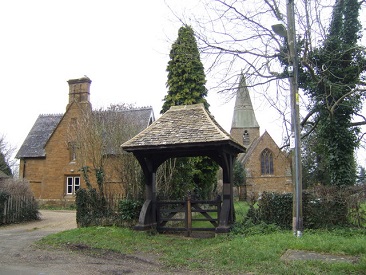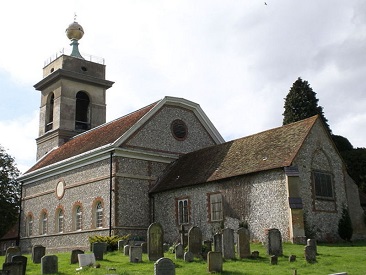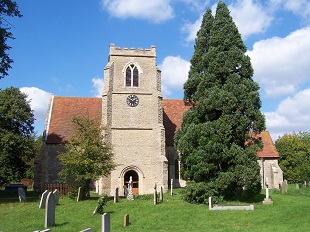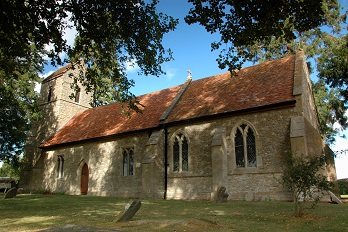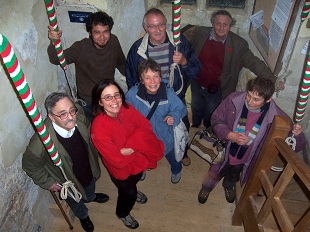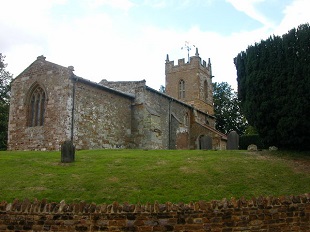Outings 2008 - 2007
by Hugh Deam
Mini Outing to Warwickshire
Sunday 30th November 2008
Shotteswell
St Laurence (6) 9cwt
The Plough
Warmington
Radway
St Peter (5) 5cwt GF
Bob Benstead, Anthony Hughes, Judith Kirby, Donna Murphy, Christian Burrell, Roy Jones, Jan Lawrie, Stephen & Graham Nichols, Hugh Deam, Susan King and Bernard Masterman.
Shotteswell First noted as Soteswell in 1140 the village derives its name from a stretch of the stream here thought to once belong to a man called Scot. The church is situated on the slopes of a steep hill with a plethora of entrances to the churchyard, and surrounded by many stone-built cottages, although parking is some considerable distance from the church. The bells are rung from the ground floor and were augmented to a six in 1995 and require tidy handling at backstroke to get the striking right.
The Plough A thoroughly cosy and atmospheric pub serving nourishing meals ideal to revivify the most exhausted of ringers.
Radway The village is generally thought to take its name from the reddish soil prevalent of the area, with "weia" referring to the road between the village and Little Kineton known locally as the Red Lane. During Saxon times Radway belonged to the Church of Coventry, and then later came under the influence of the Cistercian monks of Stoneleigh. The parish church was rebuilt on its present site and consecrated in 1866 using much of the original material. The bells were re-hung in 1949 and are rung from the ground floor.
Training Morning
Saturday 25th October 2008
Hillesden
Bucks All Saints (6) 9-0-12 in G#
Hugh Deam, Hal Drysdale, Roy Jones, Judith Kirby, Ryan Noble, Heather Dobson, Ann Gyngell, Susan King, Bernard Masterman and Charles Smith.
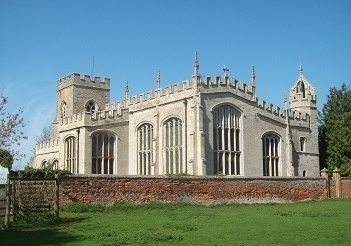
Hillesden · All Saints
The hamlet of Ilesdone was in the possession of Notley Abbey from 1164 up until late C15th, when dissention over the somewhat dilapidated state of the church led to the land being sold to Hugh de Bolebec, and the rebuilding of the church in 1493. The original Hillesden House served as a fortified outpost for Royalist forces during the Civil War, with the second besiegement by Parliamentary troops being led by Col. Oliver Cromwell. The north door of the majestic Grade I Listed church here still bears the scars of musket holes from that time. The famed architect Sir George Gilbert Scott was born in nearby Gawcott and was responsible for much of the restoration work on Hillesden church, which is often described as "the cathedral in the fields", located as it is adjacent to a deer park. The bells are now rung from a gallery and are conducive to minor method ringing, although the 2 and tenor are both being apt to drop if handling slackens.
Three quarter peals in Northamptonshire
Saturday 18th October 2008
Easton Maudit
St Peter & St Paul (5) 14-1-10 in F
Grendon
St Mary (6) 14-0-10 in F#
Bozeat
St Mary (6) 16-2-6 in E
Christian Burrell, Hugh Deam, Andy Dunn, Simon Edwards, Roy Jones and Maarit Kivilo.
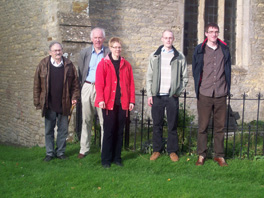
Easton Maudit The village gained its manorial affix from the Maudit family, here since the Norman Conquest. The graceful C15th spire is one of the great landmarks of the Nene Valley, particularly when floodlit, having been repaired in 1990. Hatchments and bannerols of the last of the Yelverton family, the Earls of Sussex, are to be seen in the north aisle. The noted antiquarian Thomas Percy served as rector here in late C18th, and in a front pew of the nave there is a plaque recording visits by members of the exclusive Garrick Club of which he was a member. Part of the churchyard is now a dedicated conservation area, rich in grassland species.
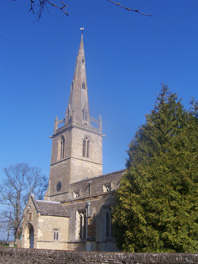 Of the five bells, three of the four C17th bells were cast by Hodson, with the other being medieval, recast in 1892. Rung from the ground floor, the bells require extreme diligence in handling.
Grendon Taking its name from "green hill", the majority of land in this area is owned by three major landowners: the Queen, Trinity College Cambridge and the Marquess of Northampton. The name of the pub, The Half Moon, is thought to refer to drunken revellers (moonrakers) in centuries past who attempted to fish the reflection of the moon out of the brook that runs through the centre of the village. The house and grounds of the manor house here, Grendon Hall, were used by the SOE to house and train Free French Forces during the Second World War. Only traces remain of the original Norman church, the advowson of which was granted to King's Hall, Cambridge by Edward III in 1342, later transferring to Trinity College.
Of the five bells, three of the four C17th bells were cast by Hodson, with the other being medieval, recast in 1892. Rung from the ground floor, the bells require extreme diligence in handling.
Grendon Taking its name from "green hill", the majority of land in this area is owned by three major landowners: the Queen, Trinity College Cambridge and the Marquess of Northampton. The name of the pub, The Half Moon, is thought to refer to drunken revellers (moonrakers) in centuries past who attempted to fish the reflection of the moon out of the brook that runs through the centre of the village. The house and grounds of the manor house here, Grendon Hall, were used by the SOE to house and train Free French Forces during the Second World War. Only traces remain of the original Norman church, the advowson of which was granted to King's Hall, Cambridge by Edward III in 1342, later transferring to Trinity College.
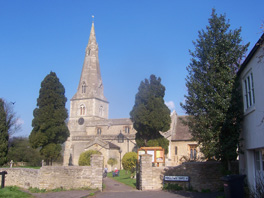 The original wooden framed clock of 1690 is still to be seen inside the church, which boasts an expansive nave. The bells are a fluent six that are now rung from a gallery.
Bozeat A Roman settlement of some importance is known to have existed here following excavations in 1964 revealed a circular building from the 2nd century that was 48ft in diameter. As a result of this a further excavation was carried out and this revealed many fragments of C1st to C3rd habitation. The handsome parish church constructed of grey stone is flanked by delightful cottages in a classic middle England scenario. The historic tower, dating back to Norman times, is capped by a broach spire, although it was partially rebuilt in late C19th, along with the main body of the church. The bells were augmented to a six in relatively recent times and are sublime in their fluidity and emanation of sound.
The original wooden framed clock of 1690 is still to be seen inside the church, which boasts an expansive nave. The bells are a fluent six that are now rung from a gallery.
Bozeat A Roman settlement of some importance is known to have existed here following excavations in 1964 revealed a circular building from the 2nd century that was 48ft in diameter. As a result of this a further excavation was carried out and this revealed many fragments of C1st to C3rd habitation. The handsome parish church constructed of grey stone is flanked by delightful cottages in a classic middle England scenario. The historic tower, dating back to Norman times, is capped by a broach spire, although it was partially rebuilt in late C19th, along with the main body of the church. The bells were augmented to a six in relatively recent times and are sublime in their fluidity and emanation of sound.

Easton Maudit

Bozeat · St Mary
Meon Valley, Hampshire
Saturday 11th October 2008
Shedfield
St John the Baptist (8) 12cwt
Wickham
St Nicholas (6) 8cwt
Purbrook
St John the Baptist (6) 5cwt
The Vine
Hambledon
Hambledon
St Peter & St Paul (6) 10cwt
Swanmore
St Barnabas (6) 6cwt
Janice Beale, Jane Burgess, Heather Dobson, Susan King, Serge Zvegintzov, Jonathan Beale, Ron Burgess, Hal Drysdale, Judith Kirby, Paul Bayes, Carole Beckley, Christian Burrell, Ann Gyngell, Peter Lloyd, Bob Benstead, Hugh Deam, Roy Jones and Donna Murphy.
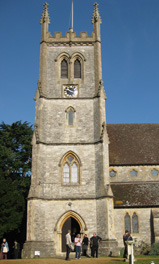
Shedfield
Shedfield The name of the village is an Old English description for open land where planks are split thin to be used for constructing foot-bridges and there are several freshwater springs in the area. The primary employment for many centuries was agriculture and horticulture, with numerous orchards. Brick-making later found a foothold here as well. The elegant parish church dates to 1875 - 80 by Colson & Son having been constructed to replace a building of early that century, although the original humble buttressed tower still stands at the rear of the churchyard. The bells are a lovely free-flowing eight.
Wickham The settlement developed around a ford across the River Meon, with a Roman military post here resulting in the construction of a bridge to facilitate the road between Noviomagus Regnorum (Chichester) and Venta Belgarum (Winchester). The name of the village derives from its association with a Vicus (a Romano-British settlement), with evidence having been found of early industry here in the form of pottery kilns. In the wake of the Norman Conquest, the Manor of Wicheham was handed to Hugo de Port as part of the Titchfield Hundred, with the church being built around 1126 and run by the Canons of Titchfield.
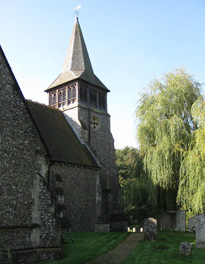 The village's most famed resident was William of Wykeham, who served as Bishop of Winchester, Chancellor of England, and founded Winchester College and New College, Oxford. The fine sounding bells are rung from a ringing chamber that is built around the organ.
Purbrook The first printed documentation of a settlement here was as Pukebrok in 1248, eerily deriving from the Old English description for a brook haunted by a goblin. The village is situated on high ground and is now effectively a northern suburb of Portsmouth with the busy A3 running through its centre having been designed as one of six forts created in the 1850s to protest the rear of the town from possible invasion by French forces. A cannon is still in place alongside the road pointing out towards the sea. The tower of St John the Baptist has a design more noted of Sussex churches with the bells being extremely easy to get the best from.
The Vine, Hambledon. A charming country pub with a strong cricketing ambience throughout and serving exceptionally well presented meals that were equally well received by all.
Hambledon The village takes its name from the description for an irregularly shaped hill, being first noted as Hamelandunae. The area is notable for its Bronze Age barrows, with remains from the Iron Age and the Roman villa of 100 AD having been unearthed. The village was granted a royal charter by King Edgar in 956, with the area belonging to Winchester during these Saxon times. Hambledon is generally regarded as being the birthplace of cricket. The original church was considered a textbook example of medieval architecture, but was severely damaged by a fire in 1794, with the tower having to be totally rebuilt. The bells are a sturdy six that are ideal for ringing minor methods.
The village's most famed resident was William of Wykeham, who served as Bishop of Winchester, Chancellor of England, and founded Winchester College and New College, Oxford. The fine sounding bells are rung from a ringing chamber that is built around the organ.
Purbrook The first printed documentation of a settlement here was as Pukebrok in 1248, eerily deriving from the Old English description for a brook haunted by a goblin. The village is situated on high ground and is now effectively a northern suburb of Portsmouth with the busy A3 running through its centre having been designed as one of six forts created in the 1850s to protest the rear of the town from possible invasion by French forces. A cannon is still in place alongside the road pointing out towards the sea. The tower of St John the Baptist has a design more noted of Sussex churches with the bells being extremely easy to get the best from.
The Vine, Hambledon. A charming country pub with a strong cricketing ambience throughout and serving exceptionally well presented meals that were equally well received by all.
Hambledon The village takes its name from the description for an irregularly shaped hill, being first noted as Hamelandunae. The area is notable for its Bronze Age barrows, with remains from the Iron Age and the Roman villa of 100 AD having been unearthed. The village was granted a royal charter by King Edgar in 956, with the area belonging to Winchester during these Saxon times. Hambledon is generally regarded as being the birthplace of cricket. The original church was considered a textbook example of medieval architecture, but was severely damaged by a fire in 1794, with the tower having to be totally rebuilt. The bells are a sturdy six that are ideal for ringing minor methods.
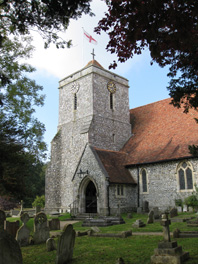
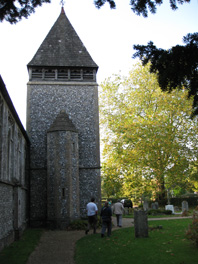
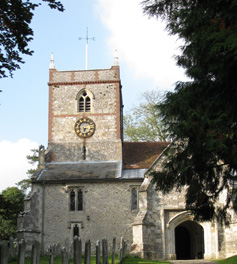 Swanmore The village is situated on the edge of what was once extensive heath-land known as Waltham Chase before drastic enclosure during C19th. Taking its name from a pool frequented by swans, the settlement was first documented in 1205. The neo-Norman church dates to 1846, with a wide nave and apsidal chancel, and an unusually situated north tower of flint and stone added in 1876/7 topped by a shingled spire. The bells are a splendid six ideal for fluent ringing across all levels.
Swanmore The village is situated on the edge of what was once extensive heath-land known as Waltham Chase before drastic enclosure during C19th. Taking its name from a pool frequented by swans, the settlement was first documented in 1205. The neo-Norman church dates to 1846, with a wide nave and apsidal chancel, and an unusually situated north tower of flint and stone added in 1876/7 topped by a shingled spire. The bells are a splendid six ideal for fluent ringing across all levels.

Wickham · St Nicholas

Purbrook

Swanmore

Hambledon
Picnic and Ringing in Oxfordshire
Saturday 12th July 2008
05.00pm Northmoor
St Denys (6) 11cwt
Jonathan Beale, Hugh Deam, Roy Jones, Judy Kirby, Paul Lucas, Bernard Masterman, Donna Murphy, Susie Pavelin and Richard Bennett.
Cambridge & Stedman.
Northmoor Documented solely as More (a marsh) in 1059, the village is located near to the ferry at Bablockhythe. Despite being somewhat off the beaten track as far as the main roads are concerned, there are a series of footpaths crossing the surrounding meadows here that make Northmoor perennially popular with ramblers and the like. Although the village has a small population it does still support a very fine pub (The Red Lion) that has long been one of the best in the county.
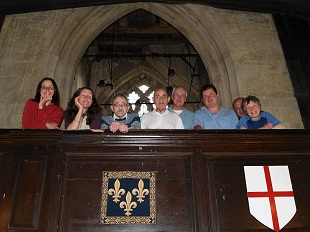
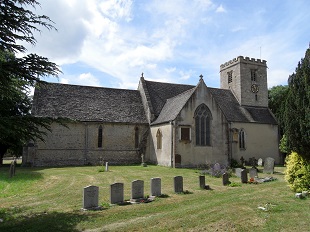 We have availed ourselves of this pub on several occasions, but obviously not on this occasion as we were picnicking. This was one of the picnics where the rain thankfully held off for our time at the church, although there had been some heavy showers earlier which made the grass out of bounds for those who had come without blankets. The impressive interior of the cruciform church, virtually unaltered from its conception, includes a 15th century nave which is rather similar to the example at Woodeaton. The bells are rung from a gallery that affords a splendid view along the length of the nave. The oldest bell is the fifth, cast by Abraham I Rudhall of Gloucester in 1717. The other five bells are from the same foundry, cast in 1764 by Thomas Rudhall.
We have availed ourselves of this pub on several occasions, but obviously not on this occasion as we were picnicking. This was one of the picnics where the rain thankfully held off for our time at the church, although there had been some heavy showers earlier which made the grass out of bounds for those who had come without blankets. The impressive interior of the cruciform church, virtually unaltered from its conception, includes a 15th century nave which is rather similar to the example at Woodeaton. The bells are rung from a gallery that affords a splendid view along the length of the nave. The oldest bell is the fifth, cast by Abraham I Rudhall of Gloucester in 1717. The other five bells are from the same foundry, cast in 1764 by Thomas Rudhall.

Northmoor

St Denys
Summer outing to the Dorset coast
Saturday 21st June 2008
Swanage
St Mary the Virgin (8) 22cwt
Worth Matravers
St Nicholas of Myra (6) 6cwt
Corfe Castle
St Edward the Martyr (6) 11cwt
Janice Beale, Christian Burrell, Roy Jones, Donna Murphy, Jonathan Beale, Hugh Deam, Susan King, June Steele, Carole Beckley, Heather Dobson, Judith Kirby, Richard Bennett, Jane Burgess, Hal Drysdale, Peter Lloyd, Ron Burgess, Sally Harrison and Bernard Masterman.
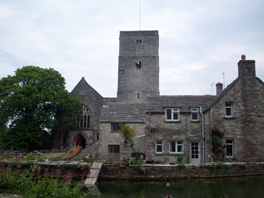
Swanage
Swanage First documented as Swanawic in late C9th the town takes its name from a farm where swans are reared. For several centuries it was merely a hamlet for fishermen and served as a Chapel of Ease for Worth Matravers until gaining its own Rector in 1497. Swanage is now a bustling seaside resort which boasts a European Blue Flag beach. The Jurassic Coast of soft shoreline sediments here has in recent years been designated as a World Heritage Site and bottle-nosed dolphins and puffins can occasionally be seen from Durlston Head. A popular steam railway, the Wessex Belle, runs on a reconstructed track between the town and Corfe. The church is constructed of Purbeck marble, with only the tower remaining from an original place of worship which has been rebuilt four times, and is adjacent to a large millpond. The coast here was first invaded on a regular basis by the Danes and later by marauding pirates, thus the tower originally had no fixed entry from the ground floor and has slit windows to best repel invaders. The top storey was added in 1620 with the oldest bell of this excellent eight dating to 1594; the ringing chamber being reached by four sets of stairs that circle the tower.
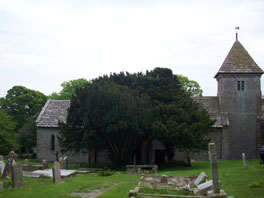 Worth Matravers This coastal village set on high ground overlooking the Jurassic Coast is comprised of many limestone cottages set around a charming central pond that is replete with a variety of fish and is regularly visited by a small clutch of ducks who rarely go hungry given the popularity of this spot with ramblers. The rocky beaches of Winspit and Seacombe are within relatively easy walking distance of Worth Matravers. The local economy has traditionally been based on farming, fishing and quarrying, but the village is now a popular tourist destination. The interior of the church contains an impressive Norman chancel arch that can be best appreciated from the gallery adjacent to the organ and ringing chamber. The fluent bells here are an augmented three that sound much lighter than might be expected from the weight of the tenor. The Worth Tearoom is but a short step from the church and made for a universally popular lunchtime destination with classic meals and ambience noted Dorset.
Worth Matravers This coastal village set on high ground overlooking the Jurassic Coast is comprised of many limestone cottages set around a charming central pond that is replete with a variety of fish and is regularly visited by a small clutch of ducks who rarely go hungry given the popularity of this spot with ramblers. The rocky beaches of Winspit and Seacombe are within relatively easy walking distance of Worth Matravers. The local economy has traditionally been based on farming, fishing and quarrying, but the village is now a popular tourist destination. The interior of the church contains an impressive Norman chancel arch that can be best appreciated from the gallery adjacent to the organ and ringing chamber. The fluent bells here are an augmented three that sound much lighter than might be expected from the weight of the tenor. The Worth Tearoom is but a short step from the church and made for a universally popular lunchtime destination with classic meals and ambience noted Dorset.
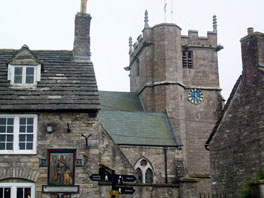 Corfe Castle The village takes its name from the Old English description for a gap amidst Nine Barrows Down on the isle of Purbeck peninsula., and is most known by its ruined castle that has experienced over 1000 years of sometimes turbulent history being situated in such a commanding position on one of the hills overlooking Corfe. Although it survived a protracted siege by Parliamentary forces throughout a large part of the English Civil War it was eventually destroyed by gunpowder in 1646. There are numerous gift shops, inns, and tea-rooms packed into a relatively small area making Corfe busier and more congested than most villages of similar size. The 1/20th scale model village directly across the road from the church also has a splendid tearoom in the courtyard fronting it. The church overlooks the south side of the central square, with the large west tower offering plenty of room in the ringing chamber; the six bells here being sublime to ring.
Corfe Castle The village takes its name from the Old English description for a gap amidst Nine Barrows Down on the isle of Purbeck peninsula., and is most known by its ruined castle that has experienced over 1000 years of sometimes turbulent history being situated in such a commanding position on one of the hills overlooking Corfe. Although it survived a protracted siege by Parliamentary forces throughout a large part of the English Civil War it was eventually destroyed by gunpowder in 1646. There are numerous gift shops, inns, and tea-rooms packed into a relatively small area making Corfe busier and more congested than most villages of similar size. The 1/20th scale model village directly across the road from the church also has a splendid tearoom in the courtyard fronting it. The church overlooks the south side of the central square, with the large west tower offering plenty of room in the ringing chamber; the six bells here being sublime to ring.

Worth Matravers

Corfe Castle
Evening Ringing & Picnic
Saturday 17th May 2008
05.30pm West Wycombe
Bucks · St Lawrence (8) 14cwt
John Beale, Jonathan Beale, Janice Beale, Bob Benstead, Robert Bruce, Christian Burrell, Hugh Deam, Hal Drysdale, Roy Jones, Judy Kirby, Bernard Masterman, Donna Murphy, Ryan Noble, Susie Pavelin and June Steele.
Plain Bob Major, Stedman Triples & Grandsire Triples.
West Wycombe First documented as Wicumun, the village was once in the possession of Bisham Abbey, and contained a crucifix that pilgrims would often kneel to kiss on their way to Saint Frideswide’s shrine in Oxford. The main street in West Wycombe consists of flint or brick Georgian buildings interspersed with 16th century timber framed houses due to the proliferation of traffic between London and Oxford during the coaching era that led to prosperity in the area. Virtually every building on the High Street is of architectural interest. In the 18th century Sir Francis Dashwood commissioned an ambitious project to supply chalk for a 3 mile road between West and High Wycombe. The pre-historic chalk cave here was expanded into an elaborate network of tunnels and passages, with local villagers, impoverished after a series of poor harvests, paid a shilling per day to tunnel underground to mine chalk. During this time, Dashwood and other high powered society figures formed a club known as the Knights of St Francis (later named the Hellfire Club by a London newspaper). They first used Medmenham Abbey for their meetings, but soon moved to the caves here. The Society of the Dilettanti became notorious for orgies and black magic. Dashwood also commissioned the construction of the Palladian mansion, with the landscaping of the park conducted by Humphry Repton. In 1929 the village was put up for sale after the Dashwood family saw much of its fortune wiped out by the Wall Street crash. The "summer church" of St Lawrence is situated at the top of the hill, and was built in its current form from 1761, officially re-opening on 3rd July 1763. The architect is unknown, but is widely believed to have been Nicholas Revett. St Paul’s church in the village is known as the "winter church". The tower is surmounted by a golden ball, 8ft in diameter, which has become synonymous with the village. It is actually made of wood and covered in gold leaf. The tower houses eight bells, the oldest of which Is the fifth from 1581 by Joseph Carter of Reading. Fourth (1621) and sixth (1620) are both by Henry I Knight at the same foundry. The other bells are all from the Whitechapel foundry, between 1756 and 1923.
Oxfordshire
Monday 28th April 2008
7.15am Brightwell Baldwin
St Bartholomew (6) 9cwt
8.30am The Lord Nelson
Brightwell Baldwin
Jane Burgess, Ron Burgess, Christian Burrell, Hugh Deam, Hal Drysdale,
Roy Jones, Judy Kirby, Maarit Kivilo and Paul Lucas.
Roy Jones, Judy Kirby, Maarit Kivilo and Paul Lucas.
Double Oxford, Single Oxford, St Clements & Plain Bob Minor.
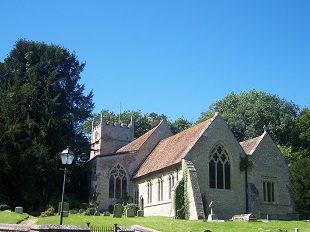
Brightwell · St Bartholomew
Brightwell Baldwin Noted as Berhtanwellan (a bright or clear spring) in 887 AD and Britewelle in the Domesday Book (1086), the later manorial affix denotes the possession of the village by Sir Baldwin de Bereford in the late 14th century. The grand 18th century mansion of Brightwell Park no longer stands, but the stable block still remains, as does the Georgian period rectory. The pub here – The Lord Nelson – is situated almost directly across the road from the church, and is, as intimated by the name, of the 18th century. The parish church was built during the 14th century in the Decorated Gothic style. The chancel includes the remains of a 13th century lancet window, a remnant of an earlier church building on the site. The stone chapel was created by John Stone in the 17th century, after he married Catherine Carleton, heiress to the manor of Brightwell Baldwin.
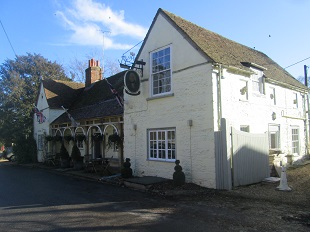 There was a modest restoration of the church in 1895, with the south porch added in 1905. The Perpendicular Gothic west tower was added in the 16th century and contains six bells which are rung from the ground floor. The oldest bell is the tenor, dating from 1559, cast by John Saunders of Reading, with the fifth from the same foundry, cast by Ellis I Knight in 1637. The front four bells all date to 1911, cast by Mears & Stainbank at Whitechapel.
The 18th century Lord Nelson Inn, situated across the road from the church, was originally constructed as a thatched cottage, with later additions to the stone building including gable ends and a distinctive veranda. Originally, the pub was known as the Admiral Nelson, but with a peerage being conferred upon him in 1797 it was renamed to reflect this. Early in the 20th century the pub was closed and converted into a shop and post office after complaints about its presence fostering drunkenness and dissolute behaviour amongst the estate workers. In 1971, after some years as a private residence the building was purchased by new owners and refitted as a pub again, appropriately re-opening for business on October 21st 1971, Trafalgar Day.
There was a modest restoration of the church in 1895, with the south porch added in 1905. The Perpendicular Gothic west tower was added in the 16th century and contains six bells which are rung from the ground floor. The oldest bell is the tenor, dating from 1559, cast by John Saunders of Reading, with the fifth from the same foundry, cast by Ellis I Knight in 1637. The front four bells all date to 1911, cast by Mears & Stainbank at Whitechapel.
The 18th century Lord Nelson Inn, situated across the road from the church, was originally constructed as a thatched cottage, with later additions to the stone building including gable ends and a distinctive veranda. Originally, the pub was known as the Admiral Nelson, but with a peerage being conferred upon him in 1797 it was renamed to reflect this. Early in the 20th century the pub was closed and converted into a shop and post office after complaints about its presence fostering drunkenness and dissolute behaviour amongst the estate workers. In 1971, after some years as a private residence the building was purchased by new owners and refitted as a pub again, appropriately re-opening for business on October 21st 1971, Trafalgar Day.

The Lord Nelson · Brightwell
Spring Outing
Saturday 29th March 2008
10.00am Great Gaddesden
Herts · St John the Baptist (6) 10cwt
11.15am Little Gaddesden
Herts · St Peter & St Paul (6) 6cwt
12.30pm Studham
Beds · St Mary the Virgin (6) 10cwt
01.30pm Lunch The Red Lion
Studham
03.00pm Whipsnade
Beds · St Mary Magdalen (6) 3cwt
04.15pm Aldbury
Herts · St John the Baptist (6) 6cwt
Janice Beale, Christian Burrell, Malcolm Fairburn, Bernard Masterman, Jonathan Beale, Ian Davey-Wilson, Adrian Gray, Donna Murphy, Carole Beckley, Hugh Deam, David Ingrouille, Ryan Noble, Bob Benstead, Heather Dobson, Roy Jones, Susie Pavelin, Jane Burgess, Hal Drysdale, Susan King, Ailsa Reid, Ron Burgess, Clare Fairburn, Judith Kirby, June Steele and Serge Zvegintzov.
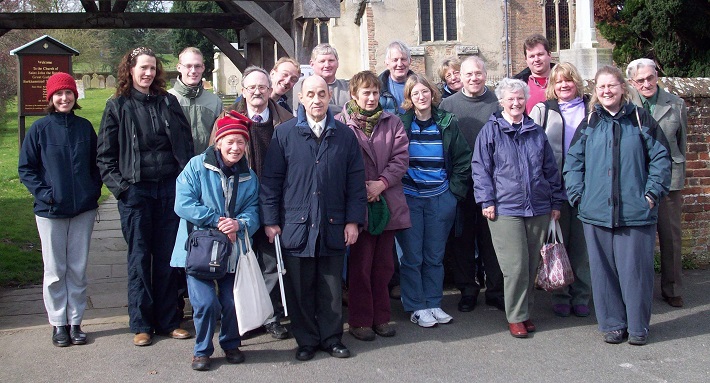
Great Gaddesden · St John
Great Gaddesden The twin Gaddesden villages derive their name from the River Gade here, which in turn took its name from the description for a valley belonging to Gaete. The Halsey family have been the Patrons of the living here since 1544, and a legacy in memory of Dorothy Abdy is given annually to eight widows in the form of tea and sugar. The middle four bells date back to 1662, tenor (1723) and treble added in 1928.
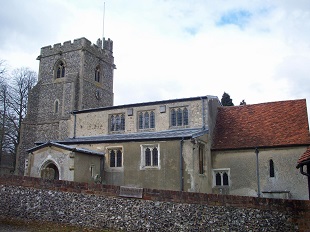
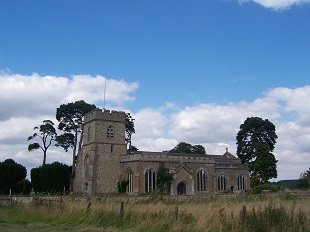 Little Gaddesden The village is set on a high spur of the Chilterns (646ft) and is bordered on three sides by Buckinghamshire, with the agricultural land of the Gade Valley to the east. The Manor of Little Gaddesden was documented in the Domesday Survey as being in the fee of the Count of Mortain. The church has undergone much repair and rebuilding down the centuries and the C15th tower and nave arcades are the oldest original work now remaining. The tenor bell here is one of the oldest surviving full-circle bells, dating to circa 1450. The No. 3 bell dates to 1654, with the other four bells added in 1977. The guiding makes this ground-floor ring a pleasing experience.
Studham The village takes its name from the Old English description for a homestead where a herd of horses are kept, with the parish straddling two counties, namely the hundred of Dacorum (Herts) and Manshead (Beds), until late C19th. Elegantly grouped around crossroads, houses and the Red Lion pub, which provided a splendid lunch for us, overlook a large common and the village war memorial in the form of a clock tower. The church is a mixture of styles from C13th onwards with a fine interior, which includes an earlier Norman font decorated with dragons and surrounded by medieval floor tiles as well as four bay arcades of 1210 - 20. Excellent bells.
Little Gaddesden The village is set on a high spur of the Chilterns (646ft) and is bordered on three sides by Buckinghamshire, with the agricultural land of the Gade Valley to the east. The Manor of Little Gaddesden was documented in the Domesday Survey as being in the fee of the Count of Mortain. The church has undergone much repair and rebuilding down the centuries and the C15th tower and nave arcades are the oldest original work now remaining. The tenor bell here is one of the oldest surviving full-circle bells, dating to circa 1450. The No. 3 bell dates to 1654, with the other four bells added in 1977. The guiding makes this ground-floor ring a pleasing experience.
Studham The village takes its name from the Old English description for a homestead where a herd of horses are kept, with the parish straddling two counties, namely the hundred of Dacorum (Herts) and Manshead (Beds), until late C19th. Elegantly grouped around crossroads, houses and the Red Lion pub, which provided a splendid lunch for us, overlook a large common and the village war memorial in the form of a clock tower. The church is a mixture of styles from C13th onwards with a fine interior, which includes an earlier Norman font decorated with dragons and surrounded by medieval floor tiles as well as four bay arcades of 1210 - 20. Excellent bells.
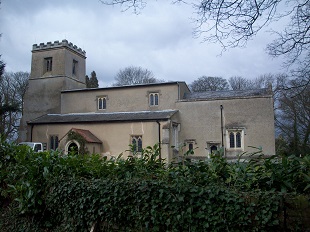
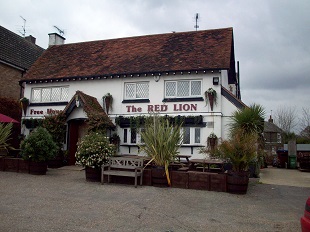 Whipsnade The first documentation of a settlement here was in 1202 when the farmstead was known as Wibsnede (A detached plot belonging to Wibba). Set amidst common-land, the village contains several attractive timber-framed houses and a footpath across the road from the main bulk of housing leads towards the Tree Cathedral where trees were planted as a memorial by Edmund Kell Blyth just after World War I in the configuration of Liverpool Cathedral. In 1931 London Zoo chose Whipsnade as the country home for its animals and this Wildlife Park is now internationally famous with a 160 yard long representation of a white lion carved into the chalky hillside visible from the Chiltern ridges to the west. The church is constructed primarily of brick on the site of an earlier chapel, with an extremely light augmented ring of six.
Whipsnade The first documentation of a settlement here was in 1202 when the farmstead was known as Wibsnede (A detached plot belonging to Wibba). Set amidst common-land, the village contains several attractive timber-framed houses and a footpath across the road from the main bulk of housing leads towards the Tree Cathedral where trees were planted as a memorial by Edmund Kell Blyth just after World War I in the configuration of Liverpool Cathedral. In 1931 London Zoo chose Whipsnade as the country home for its animals and this Wildlife Park is now internationally famous with a 160 yard long representation of a white lion carved into the chalky hillside visible from the Chiltern ridges to the west. The church is constructed primarily of brick on the site of an earlier chapel, with an extremely light augmented ring of six.
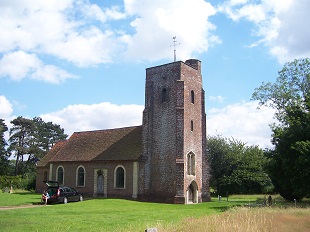
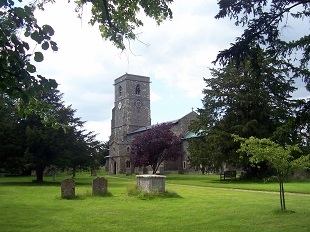 Aldbury This much photographed village is rightly regarded as being amongst the most beautiful in the country, although the derivation of its name (a disused fort) gives little clue to its beauty. The castle that stood here until C14th served as the home to the sinister Sir Guy de Gravade who took a keen interest in the dark arts and tried to turn base metals into gold. A half-timbered manor house and a large pond are situated at the central crossroads in the village, with stocks and whipping post adjoining the pond serving as a reminder of the governmental responsibilities of the local squire. The parish church has a slender west tower, with the numbers 4 to 6 bells dating successively to 1634/55/83, the front three being added in 1984. Excellent bells.
Aldbury This much photographed village is rightly regarded as being amongst the most beautiful in the country, although the derivation of its name (a disused fort) gives little clue to its beauty. The castle that stood here until C14th served as the home to the sinister Sir Guy de Gravade who took a keen interest in the dark arts and tried to turn base metals into gold. A half-timbered manor house and a large pond are situated at the central crossroads in the village, with stocks and whipping post adjoining the pond serving as a reminder of the governmental responsibilities of the local squire. The parish church has a slender west tower, with the numbers 4 to 6 bells dating successively to 1634/55/83, the front three being added in 1984. Excellent bells.

Great Gaddesden · St John

Little Gaddesden · St Peter

Studham · SMV

The Red Lion · Studham

Whipsnade · St Mary

Aldbury · St John
Mini-outing
Saturday 8th March 2008
10.00am Wotton Underwood
Oxon · All Saints (6) 10cwt
11.15am Ludgershall
Oxon · St Mary the Virgin (5) 9cwt
12.30pm Launton
Oxon · Assumption of the BVM (6) 6cwt
Bob Benstead, Susan King, Ann Mayou, Serge Zvegintzov, Hugh Deam, Judith Kirby, Graham Nicholls, Steve Jeffery, Anthony Hughes, Peter Lloyd, Stephen Nicholls, Roy Jones, Paul Lucas, Susie Pavelin, Paul Kimber, Bernard Masterman and June Steele.
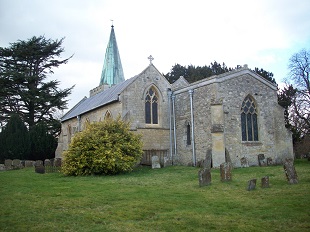
Wotton Underwood
Wotton Underwood Taking its name from the Anglo-Saxon for a farm near a wood, the settlement here at the time of the Domesday Book was noted as Oltone. Probably the grandest feature of this small and remote village is Wotton House which was built between 1704 - 1714 by master mason John Keene on a model that was created by William Winde, and is reputed to be almost identical to Buckingham House - the forerunner to what is now Buckingham Palace. The south pavilion of the house served as the home to famed Shakespearean actor Sir John Gielgud up until his death in the late 1990s. The church, which stands in the grounds of the estate, is almost wholly an incongruous C19th rebuild by G.E. Street, but containing much of interest inside, including a Norman frieze and a carved stone screen added at the behest of the 2nd Duke of Buckingham. The bells are rung from the ground floor and trip round nicely.
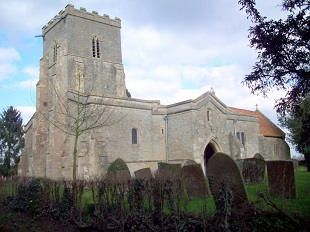 Ludgershall The Domesday Survey notes the settlement here at that time as Lotegarser, meaning a nook with a trapping spear. A myriad of roads meet in the village, which is notable for its hilly open spaces similar to nearby Brill, with a mill mound dating back to medieval times on its northerly edge. The parish church, framed by many mature trees, is situated on the southern edge of Ludgershall, and various extensions down the years are easy to discern, with the best view gained from the south side as the churchyard is vast. The bells are rung from a gallery and are one of the most fluent sets of five around.
Launton Originally known as Longtune (a long farmstead) in 1050, the village name of today emerged as Launton rather than the usual modern day name of Langton; the village is also unusual in having two similarly named pubs, The Bull and The Black Bull.
Ludgershall The Domesday Survey notes the settlement here at that time as Lotegarser, meaning a nook with a trapping spear. A myriad of roads meet in the village, which is notable for its hilly open spaces similar to nearby Brill, with a mill mound dating back to medieval times on its northerly edge. The parish church, framed by many mature trees, is situated on the southern edge of Ludgershall, and various extensions down the years are easy to discern, with the best view gained from the south side as the churchyard is vast. The bells are rung from a gallery and are one of the most fluent sets of five around.
Launton Originally known as Longtune (a long farmstead) in 1050, the village name of today emerged as Launton rather than the usual modern day name of Langton; the village is also unusual in having two similarly named pubs, The Bull and The Black Bull.
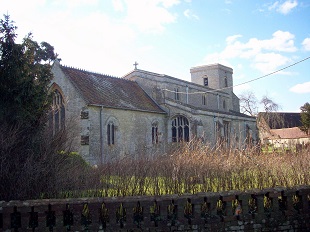
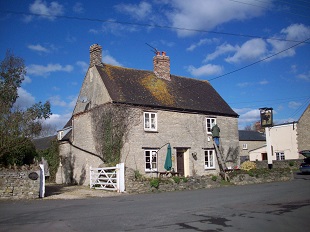 The church dates primarily to C12th / C13th, although major alterations were made during the 15th century. The east window is a memorial to Bishop Skinner who retired here during the Civil War when he was ejected from the Bishopric of Oxford, but covertly continued to take services and ordained over 300 clergymen. A further window memorial commemorates a former rector here, Dr. J.C. Blomfield, later Bishop of London, whose son Sir Arthur Blomfield found fame as one of the finest ever church architects. The bells are a pleasant six, although the ringing chamber is one of the smallest in the country for the number of bells.
The church dates primarily to C12th / C13th, although major alterations were made during the 15th century. The east window is a memorial to Bishop Skinner who retired here during the Civil War when he was ejected from the Bishopric of Oxford, but covertly continued to take services and ordained over 300 clergymen. A further window memorial commemorates a former rector here, Dr. J.C. Blomfield, later Bishop of London, whose son Sir Arthur Blomfield found fame as one of the finest ever church architects. The bells are a pleasant six, although the ringing chamber is one of the smallest in the country for the number of bells.

Ludgershall · SMV

Launton · ABVM

Launton · The Black Bull
Northamptonshire
Saturday 16th February 2008
Rothersthorpse
St Peter & St Paul (5) 11cwt
Milton Malsor
Holy Cross (5) 11cwt
Blisworth
St John The Baptist (6) 12cwt
Blisworth
The Royal Oak
Hugh Deam, Roy Jones, Maarit Kivilo, Simon Edwards, Christian Burrell and Andy Dunn.
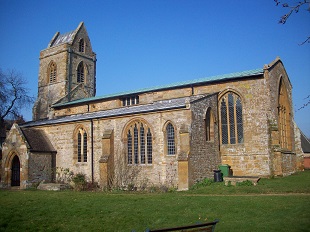
Rothersthorpe · St Peter
Rothersthorpse The Domesday Book describes the settlement here at that time as Torp, deriving from Old Scandinavian, with a later elongation (1231) to Retherestorp (outlying farmstead belonging to the advocate). The area is known to have been settled by the Celts during the Bronze Age as the village is on the line of the Jurassic Way, with the Romans later having a significant presence here, the Watling Road (now the A5) passing close by. Evidence of a Roman villa here in the Loundes valley was uncovered and catalogued by the vicar of nearby Gayton (Dr Butler) in 1840. A major battle is known to have been fought on the outskirts of the village between the forces of Edward the Elder and an army of marauding Danes during the years when the Vikings regularly raided these shores. In later centuries Welsh sheep drovers regularly used the village as a centre from which to barter their sheep, and later still the course of the Grand Union Canal took in the western edge of the village.
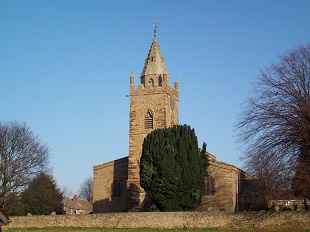 The C13th church has a west tower with a saddleback (described locally as pack-saddle) roof. The church contains an inscribed propeller blade recovered from a Wellington bomber that crashed in the village in 1944. This was long a four-bell tower until the addition of a fifth bell in 1914.
Milton Malsor The settlement was first known as Mideltone (a middle farmstead), but in 1781 the name was amended to Milton alias Middleton Malsour from the influential Malesoure family, here from C12th. There a two grand houses of note within the village, with Milton Manor House containing a C17th staircase that is comparable to the more famous mansions at Lamport Hall and Castle Ashby. The present church building is 12th century, with a distinctive crocketted spire and a superb Catherine Wheel window distinguishing the north chapel; it is set to celebrate its 850th anniversary in 2010. Although now known as Holy Cross, the church was originally dedicated to St Helen. To the west of the bell-tower is an oak tree that was planted in 1966, having been grown from an acorn brought from Blenheim Palace. Although now known as Holy Cross, the church was originally dedicated to St Helen. To the west of the bell-tower is an oak tree that was planted in 1966, having been grown from an acorn brought from Blenheim Palace.
The C13th church has a west tower with a saddleback (described locally as pack-saddle) roof. The church contains an inscribed propeller blade recovered from a Wellington bomber that crashed in the village in 1944. This was long a four-bell tower until the addition of a fifth bell in 1914.
Milton Malsor The settlement was first known as Mideltone (a middle farmstead), but in 1781 the name was amended to Milton alias Middleton Malsour from the influential Malesoure family, here from C12th. There a two grand houses of note within the village, with Milton Manor House containing a C17th staircase that is comparable to the more famous mansions at Lamport Hall and Castle Ashby. The present church building is 12th century, with a distinctive crocketted spire and a superb Catherine Wheel window distinguishing the north chapel; it is set to celebrate its 850th anniversary in 2010. Although now known as Holy Cross, the church was originally dedicated to St Helen. To the west of the bell-tower is an oak tree that was planted in 1966, having been grown from an acorn brought from Blenheim Palace. Although now known as Holy Cross, the church was originally dedicated to St Helen. To the west of the bell-tower is an oak tree that was planted in 1966, having been grown from an acorn brought from Blenheim Palace.
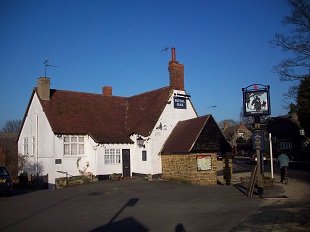
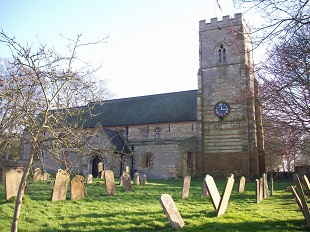 Blisworth The village takes its name from "Blith's Enclosure", being described in the Domesday Book as Blidesworde. Although very rural in most aspects Blisworth has an industrial history, being on road, water, and rail links from Northampton. There are two Heritage Walks incorporating the village. The Royal Oak Inn stands at the central road junction of Blisworth. The present church is built upon various churches all sited here before the Norman Conquest. The bells were re-hung with a metal frame in 2004, although the original wooden frame remains in its original position directly above the new frame. A peal-board here commemorates the simultaneous peals rung here and at nearby Stoke Bruerne on March 25th 2005 to celebrate the two-hundredth anniversary of the opening of the Blisworth Tunnel on the Grand Union Canal. The newly formed wooden floor covers the three stone steps of the original ringing floor down to the nave.
Blisworth The village takes its name from "Blith's Enclosure", being described in the Domesday Book as Blidesworde. Although very rural in most aspects Blisworth has an industrial history, being on road, water, and rail links from Northampton. There are two Heritage Walks incorporating the village. The Royal Oak Inn stands at the central road junction of Blisworth. The present church is built upon various churches all sited here before the Norman Conquest. The bells were re-hung with a metal frame in 2004, although the original wooden frame remains in its original position directly above the new frame. A peal-board here commemorates the simultaneous peals rung here and at nearby Stoke Bruerne on March 25th 2005 to celebrate the two-hundredth anniversary of the opening of the Blisworth Tunnel on the Grand Union Canal. The newly formed wooden floor covers the three stone steps of the original ringing floor down to the nave.

Milton Malsor · Holy Cross

The Royal Oak · Blisworth

Blisworth · St John
Oxfordshire
Saturday 9th February 2008
10.00am Great Milton
SMV (8) 18cwt
Jane Burgess, Ron Burgess, Christian Burrell, Hugh Deam, Andrew Dunn, Rev Anthony Ellis, Carl Griffin, Roy Jones, Susan King, Judy Kirby, David Lane, Katie Lane, Peter Lloyd, Bernard Masterman and Paul Morley.
Cambridge Major, Plain Bob Major, Stedman Triples, Single Oxford Triples & Grandsire Triples.
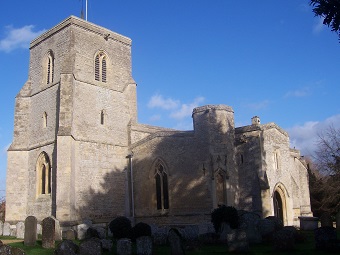
Great Milton · SMV
Great Milton The village is formed into distinctive parts, with cottages and inns beside the large green along Sworford Lane, while across the wooded stream there are substantial houses standing in expansive grounds. Local tradition has it that John Milton not only originated from Great Milton, but also wrote much of Paradise Lost here, his father having been the ranger for nearby Shotover Forest. Adjoining the churchyard is Le Manoir Aux Quat Saisons, one of the country’s most highly rated restaurants, owned by one of the world’s greatest chefs, Raymond Blanc OBE. The restaurant has two Michelin stars and is in the highest echelons of the Laurent Perrier Top 100. The earliest church known to have existed here was administered by the Bishop of Lincoln. During the Middle Ages the church and village were situated closer together than they are now, the greater part of the new housing having been built westwards. The parish church is primarily 14th century as a result of a fire early that century destroying parts of the Norman original and necessitating a wide-ranging rebuilding, with the aisle, south porch and eastern half of the chancel dating from the time. The west tower was built during the following century, with a restoration of the church in 1850 carried out by George Gilbert Scott. The interior of the church contains a Jacobean pulpit and elaborate memorials to the Dormer family. A new team of bell-ringers was recruited in the lead up to the Millennium, and the momentum has been maintained since, ensuring that this excellent set of bells is rung regularly. The oldest bell here is the fourth, cast in 1631 by Ellis I Knight of Reading, with the fifth and seventh from the same foundry in 1673. The front three bells (1771) and tenor (1772) are all by Thomas Rudhall of Gloucester. The sixth is from 1848, cast by William Taylor of Oxford. Being situated adjacent to Le Manoir the bells are often rung for weddings being conducted there as well as in the church itself.
A record of outings 2007
by Hugh Deam
Mini-Outing
Saturday 17th November 2007
Tetsworth
St Giles (6) 4cwt
Towersey
St Catherine (4) 7cwt
Emmington
St Nicholas (3) 6cwt
Chinnor
St Andrew (6) 10cwt
Paul Bayes, Hugh Deam, Judith Kirby, Bernard Masterman, Robert Bruce, Anthony Hughes, Jan Lawrie, Donna Murphy, Andy Bryant, Roy Jones, Maarit Kivilo, Susie Pavelin, Christian Burrell, Susan King, Peter Lloyd and June Steele.
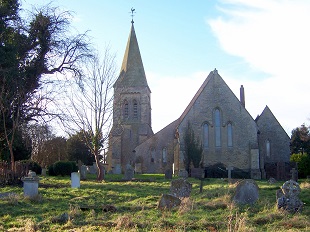
Tetsworth · St Giles
Tetsworth The village is situated on the fertile plain of the Chiltern escarpment and derives its name from Taetel's enclosure, being documented as Tetleswrthe circa 1150. The main trunk road between Oxford and London long ran through Tetsworth and the broach spire of the church is easily visible from the M40. Although the village no longer has a general store it does specialise in antique shops, and is known to many outsiders for being the venue of a massive weekly Car Boot Sale during the summer months. The parish church was rebuilt in 1855 by J Billing in the Early English style as a replacement for what had once been an elaborate Norman building. The bells are a splendid light six.
Towersey At the time of the Domesday Survey the small farmstead here was known merely as Eie (an island), with the manorial affix dating to 1240 and the then ownership by the de Turs family when it was renamed Turrisey. The village retains many elegant half-timbered cottages and is almost certainly best known to outsiders for its Festival, which has been held annually at the end of August for the past 43 years. This is one of the most popular small music festivals in the country, with folk, acoustic and new world music to the fore. The C14th parish church was largely rebuilt by Cranston during the 19th century, with the tower added over the porch 1850-54. The four bells definitely require tight handling, and reward with a good tone outside.
Emmington Known as Amintone (Eama's Farm) in 1086, Emmington is more like a hamlet than a village, reached via a narrow lane, and consisting of a mere handful of cottages, a church, a large duck-pond, a modern mansion house, and a pub on the main road between Thame and Chinnor. The early C14th church was rebuilt in 1874 by Buckeridge and Pearson to the original plan, and possesses a saddleback roof to its tower. It was declared redundant in 1987, but the tower was strengthened and new fixtures added to allow the bells to be rung again, and they considerably easier to ring than most three bell sets. Access to the church and surrounding land is by prior appointment only.
Chinnor See the outing on Sat 21st April 2007.
Northamptonshire
Saturday 27th October 2007
10.30am Naseby
All Saints (5) 12cwt
11.45am Sibbertoft
St Helen (5) 10cwt
01.00pm Lunch The Red Lion
Sibbertoft
02.45pm Cold Ashby
St Denys (6) 7cwt
Roy Jones, Halisi Drysdale, Susie Pavelin, Judith Kirby, Peter Lloyd, Anthony Hughes, Susan King and Hugh Deam.
Plain Bob Minor, Stedman, St Simon’s & Grandsire.
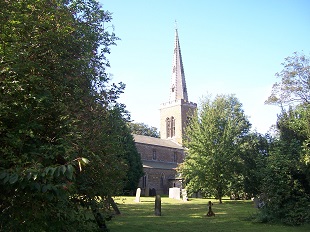
Naseby · All Saints
Naseby Known as Navesberie (Hnaef’s stronghold) in 1086, the village is known to have been occupied by the Vikings at some point, hence their influence on the name. There are two monuments commemorating the decisive Civil War battle that was fought here in 1645. The 30ft high Naseby Obelisk, sited on an old windmill mound, is from 1823, which at the time was thought to mark the spot of the fighting. Naseby Monument on the other side of the village is the work of C.H. Reich, dating to 1936, which accurately marks the area where the Parliamentarian forces massed prior to engaging the Royalist troops. After Royalist success at Edgehill and Parliamentarian victory at Marston Moor, this battle proved the most decisive of the entire war, with sufficient field army and experienced infantry officers captured by Cromwell that the die had been cast for King Charles. The spire of the 13th century church is visible from well beyond the boundaries of the parish such is its majesty as it rises up above the tree-laden churchyard. The south arcade of three-bays, with quatrefoil piers and leaf capitals with faces between leaves is considered to be one of the finest such examples in the county. The bells are rung from the ground floor and emanate a superb tone. Three of the bells are by Hugh II Watts of Leicester, 1633 (4 & 5) and 1640 (2), with the other two bells from 1939, by Taylors of Loughborough.
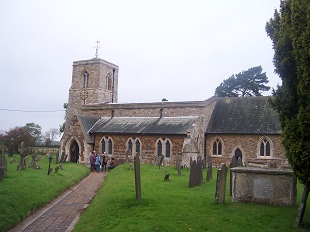 Sibbertoft The unusual name of the village derives from Sigebeorht’s homestead. Skirting the northern edge of the village is a small wooded area that hides the remnants of an ancient motte-and-bailey known as Castle Yard. One of the early Lords of the Manor, Brabazon, was granted the right to hold Saturday markets from 1309, this weekly market going by the grand name of The Invention of the Holy Cross, referencing the church here dedicated to St Helen, and her discovery of the site of the Crucifixion in Jerusalem. By the 18th century flax weaving had become the main industry in the village, along with agricultural employment in the surrounding district. The earliest parts of the church date to the 13th century, the chancel being of this time, with a stained-glass window dedicated to St Alban and St Helen. The church was mostly rebuilt 1862/63, with the south aisle added. The bells are rung from the ground floor, but are well guided. The oldest bell is the tenor, cast in 1825 by W & J Taylor of Oxford, to celebrate the 21st birthday of George Payne of Sulby, who was reputed to be the youngest son of George IV from his secret marriage to Maria FitzHerbert. The other bells are from Whitechapel and Taylor’s subsequent foundry in Loughborough.
Cold Ashby The village takes its name from the Anglo-Saxon for a farmstead where ash trees grow, being noted as Essebi in 1086, with the affix recognising the cold and exposed nature of this area. The British Ordnance Survey’s first trig-pillar, the triangular post used by surveyors, is sited close to the village. More than 11,000 of these posts were erected across the country in order to enable maps to be created accurate to within yards by measuring angles and using trigonometry to calculate distances between the pillars. The stately parish church is set on high ground to the south of the village, with a Norman inner arch surrounded by a Perpendicular period enlargement. The Royal Coat of Arms of George III (1778) is above the vestry door, and the gallery was built in 1789 to house musicians accompanying the services. The superb High Victorian style lych-gate is from 1883. The west tower was added in the 15th century, with embattled parapet and corner pinnacles. The bells were augmented to a six in 2004 and are no longer classified as being rung from the ground floor as the floor was raised slightly at this time. The back two bells date back to 1606, cast by Edward Newcombe of Leicester foundry.
Sibbertoft The unusual name of the village derives from Sigebeorht’s homestead. Skirting the northern edge of the village is a small wooded area that hides the remnants of an ancient motte-and-bailey known as Castle Yard. One of the early Lords of the Manor, Brabazon, was granted the right to hold Saturday markets from 1309, this weekly market going by the grand name of The Invention of the Holy Cross, referencing the church here dedicated to St Helen, and her discovery of the site of the Crucifixion in Jerusalem. By the 18th century flax weaving had become the main industry in the village, along with agricultural employment in the surrounding district. The earliest parts of the church date to the 13th century, the chancel being of this time, with a stained-glass window dedicated to St Alban and St Helen. The church was mostly rebuilt 1862/63, with the south aisle added. The bells are rung from the ground floor, but are well guided. The oldest bell is the tenor, cast in 1825 by W & J Taylor of Oxford, to celebrate the 21st birthday of George Payne of Sulby, who was reputed to be the youngest son of George IV from his secret marriage to Maria FitzHerbert. The other bells are from Whitechapel and Taylor’s subsequent foundry in Loughborough.
Cold Ashby The village takes its name from the Anglo-Saxon for a farmstead where ash trees grow, being noted as Essebi in 1086, with the affix recognising the cold and exposed nature of this area. The British Ordnance Survey’s first trig-pillar, the triangular post used by surveyors, is sited close to the village. More than 11,000 of these posts were erected across the country in order to enable maps to be created accurate to within yards by measuring angles and using trigonometry to calculate distances between the pillars. The stately parish church is set on high ground to the south of the village, with a Norman inner arch surrounded by a Perpendicular period enlargement. The Royal Coat of Arms of George III (1778) is above the vestry door, and the gallery was built in 1789 to house musicians accompanying the services. The superb High Victorian style lych-gate is from 1883. The west tower was added in the 15th century, with embattled parapet and corner pinnacles. The bells were augmented to a six in 2004 and are no longer classified as being rung from the ground floor as the floor was raised slightly at this time. The back two bells date back to 1606, cast by Edward Newcombe of Leicester foundry.

Sibbertoft · St Helen
Essex
Saturday 13th October 2007
10.30am Shenfield
St Mary the Virgin (6) 9cwt
12.00pm Basildon
St Martin of Tours (8) 11cwt
01.45pm Lunch The Green Man
Herongate
02.45pm Ingrave
St Nicholas (6) 10cwt
04.00pm Navestock
St Thomas the Apostle (6) 9cwt
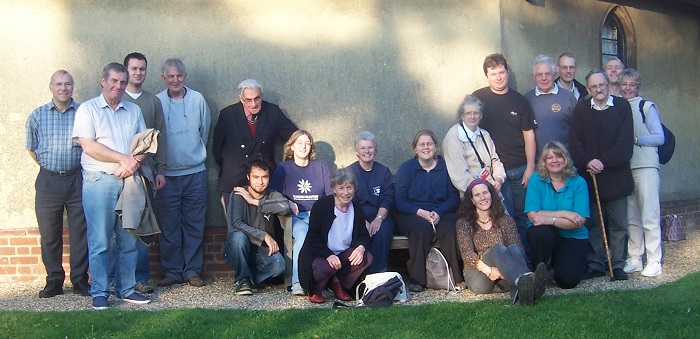
Navestock · St Thomas the Apostle
From Left to Right: Ron Burgess, Paul Bayes, Carl Griffin, Serge Zvegintzov, Bob Benstead, Halisi Drysdale, Ailsa Reid, Judith Kirby, Jane Burgess, Janice Beale, Joan Beale, Donna Murphy, Jonathan Beale, John Beale, Carole Beckley, Christian Burrell, Roy Jones, Adrian Gray and June Steele.
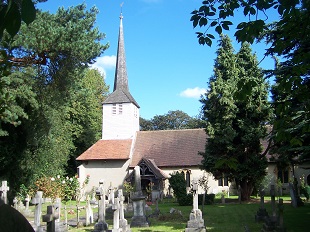
Shenfield · SMV
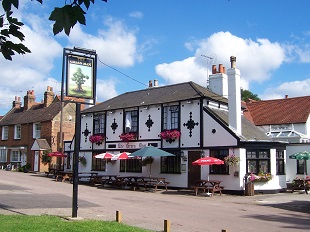
The Green Man · Herongate
Shenfield The farmstead here at the time of the Domesday Survey was documented as Scenefelda (beautiful open land) and is now virtually a northern suburb of Brentwood. The parish church is tucked away in a secluded area opposite a small meadow awash with a variety of wild flowers, ornamental fruit trees and log piles that attract songbirds, butterflies and insects. At the centre is a seat in the shape of a butterfly, a maze with beetle banks and an analemmatic sundial. The earliest parts of the church are C13th, with the tower, porch and wooden pillars added around 1500. The interior of the church lit so as to highlight the intricate cross-beamed ceiling. The weather-boarded belfry contains a ringing chamber that is an unforgettable mix of timber beams above and girders across the floor that require some dexterity to move around.
Basildon is one of 8 self-contained "new towns" around London that were established soon after World War II, Harlow being the other Essex example. Several villages were incorporated into a whole that took its name from the largest one, namely Basildon. The town grew rapidly as a result of the Ford tractor plant being sited here. The area around St Martin's Square in the northern quadrant was the last to be redeveloped, with the focal point being the 95ft high free-standing Campanile by Douglas Galloway that is bordered by the church, shopping centre and theatre.
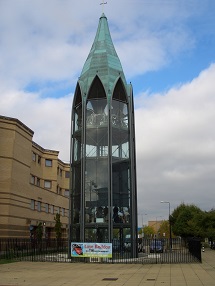
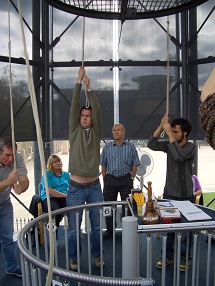
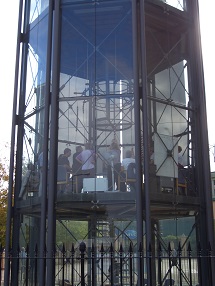 This remarkable steel structure, opened in 1999, is fully glazed and topped by a copper-covered ogee dome.
Ingrave At the time of its notation in the Domesday Book the settlement was known as Ingam, taking its name from a local tribe. During the time when the manor was held by a man named Ralf the village was called Gingeraufe, but later reverted back to something resembling the original name. The manor house of Thorndon Hall dates to 1764 and contains a mausoleum and chantry chapel, as well as retaining gardens first laid out by Lancelot Capability Brown. The parish church was built in 1735 at the behest of Lord Petre of Thorndon Hall and adheres to the classic Hawksmoor style. The tower of this striking red brick church is imposingly broad, with the interior of the church being wonderfully bright and welcoming.
This remarkable steel structure, opened in 1999, is fully glazed and topped by a copper-covered ogee dome.
Ingrave At the time of its notation in the Domesday Book the settlement was known as Ingam, taking its name from a local tribe. During the time when the manor was held by a man named Ralf the village was called Gingeraufe, but later reverted back to something resembling the original name. The manor house of Thorndon Hall dates to 1764 and contains a mausoleum and chantry chapel, as well as retaining gardens first laid out by Lancelot Capability Brown. The parish church was built in 1735 at the behest of Lord Petre of Thorndon Hall and adheres to the classic Hawksmoor style. The tower of this striking red brick church is imposingly broad, with the interior of the church being wonderfully bright and welcoming.
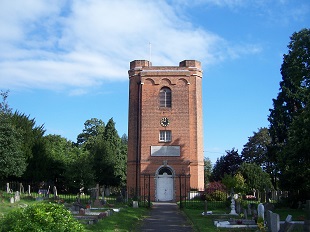
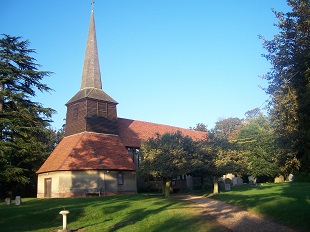 Navestock The name derives from an outlying farmstead on the Nazeing promontory, with documentation in 1086 as Nassestoca. A mere few dozen former tied cottages are spread out thinly over a huge area of countryside that has long been farmed. The heavy Essex clay meant that the meadows required intensive work by farm labourers. Many rows of cottages have subsequently been demolished and the population has actually shrunk in numbers. The 1000 year old church is one of the most handsome in the county, having been sympathetically restored by Chancellor in late C19th, and it was long associated with the Waldegrave family. Some evidence of damage done by a bombing raid during the last war is still visible. The weather-boarded belfry is topped by a shingled splay-foot spire and there has been a peal of bells here for over 600 years.
Navestock The name derives from an outlying farmstead on the Nazeing promontory, with documentation in 1086 as Nassestoca. A mere few dozen former tied cottages are spread out thinly over a huge area of countryside that has long been farmed. The heavy Essex clay meant that the meadows required intensive work by farm labourers. Many rows of cottages have subsequently been demolished and the population has actually shrunk in numbers. The 1000 year old church is one of the most handsome in the county, having been sympathetically restored by Chancellor in late C19th, and it was long associated with the Waldegrave family. Some evidence of damage done by a bombing raid during the last war is still visible. The weather-boarded belfry is topped by a shingled splay-foot spire and there has been a peal of bells here for over 600 years.

Basildon

St Martin of Tours

The 1st floor chamber

Ingrave · St Nicholas

Navestock · St Thomas
Gloucestershire
Sunday 30th September 2007
12.30pm Withington
St Michael (6) 11cwt
01.45pm The Seven Tuns
Chedworth
03.15pm Compton Abdale
St Oswald (6) 6cwt
Christian Burrell, Hugh Deam, Simon Edwards, Roy Jones, Maarit Kivilo and Janice Knowles.
Plain Bob Minor, Stedman, Winchendon, St Nicholas, St Martin’s & St Simon’s.
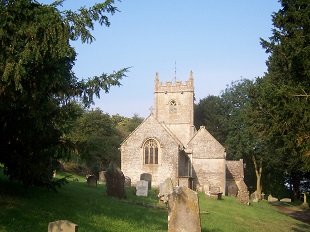
Compton Abdale · St Oswald
Withington See Saturday 10th May 2003 for details.
Compton Abdale The village is situated on what was Salt Way which ran across the Cotswolds, the salt mainly being used for curing meat to store for the winter months. Originally documented as Contone (a farmstead in a valley), the manorial affix from 1504 (Apdale Compton) denotes the Apdale family. The River Coln runs just to the south of Compton Abdale, with the flow of a small stream emerging from stones at the centre of the village known as “The Crocodile”. Also near the centre of the village is the manor house which is constructed of stone with a Cotswold tiled roof. The house is early 19th century, with later additions, set amidst four acres of land that includes a landscaped garden and a kitchen garden to the rear. On the upper reaches of the hill overlooking the stream is the parish church, which is primarily 15th century in its construction, but retaining remnants of the structure here since the 13th century. The church is built of limestone rubble, with the north aisle and tower ashlar-faced. The building consists of chancel and nave in one, a 4-bay north aisle, north porch and west tower. The entrance to the church is via a narrow terrace in the steep hillside on the south side of the village. The church was restored between 1880 and 1883 to the designs of Ewan Christian. The tower originally housed four bells, with a recasting and augmentation to six by John Warner & Son, London, in 1880.
The New Forest
Saturday 7th July 2007
Hinton Admiral
St Michael & All Angels (5) 9cwt
Brockenhurst
St Nicholas (8) 4cwt
The Snake Catcher
Brockenhurst
Lyndhurst
St Michael & All Angels (8) 11cwt
Minstead
All Saints (5) 7cwt
Jonathan Beale, Hugh Deam, Roy Jones, Peter Lloyd, Jane Burgess, Adrian Gray, Judith Kirby, Ailsa Reid, Ron Burgess, Sally Harrison, Janice Knowles and Bernard Masterman.
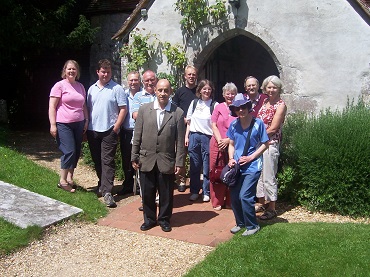
Brockenhurst
Although the most recently designated National Park (2005), the Forest is every bit as unique as the longer standing Parks, with 200 square miles of emollient scenery and whose dwellers were accorded commoners rights by William the Conqueror. During the 17th century much of the wood needed for the expansion of the Navy came from the Forest, with the plethora of conifers here stemming from the mass felling of broad-leaved trees for the war effort in World War I and the necessity for fast growing replacements. Many of the churches enjoy exquisite backdrops and the sunniest weather for some three months served to enhance the majesty.
Hinton Admiral This sporadic village, bisected by the A35, is situated on the south-western fringe of the Forest just a couple of miles to the west of Christchurch. The parish church is set adjacent to the grounds of the C18th mansion house Hinton Park, and its fabric primarily dates from the Victorian rebuild of the original 18th century construction from which only the north wall and small brick tower survives. The bells are a testing five, with the 2 needing particular attention to keep it from dropping. Despite there being less than a dozen dwellings in the village there is a bustling railway station, a petrol station and the popular Cat & Fiddle Pick Your Own Farm.
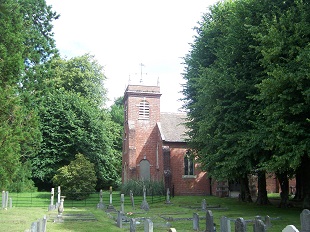
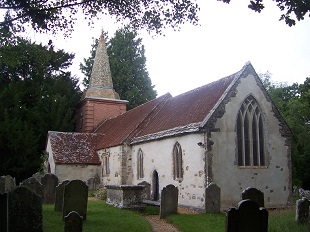 Brockenhurst Centrally located in the Forest, Brockenhurst is directly surrounded by a colourful patchwork of heather, gorse and woodland where hardy New Forest ponies and cattle roam free, especially around the photogenic Brookley water-splash which is fed by the River Lymington. The primarily Norman parish church, the oldest in the New Forest, is situated south of the village amidst a clearing in woodland. There is a New Zealand war cemetery in the churchyard that acknowledges 100 soldiers; also buried here is snake-catcher Harry Mills. The bells are a very light eight rung from the ground floor.
Brockenhurst Centrally located in the Forest, Brockenhurst is directly surrounded by a colourful patchwork of heather, gorse and woodland where hardy New Forest ponies and cattle roam free, especially around the photogenic Brookley water-splash which is fed by the River Lymington. The primarily Norman parish church, the oldest in the New Forest, is situated south of the village amidst a clearing in woodland. There is a New Zealand war cemetery in the churchyard that acknowledges 100 soldiers; also buried here is snake-catcher Harry Mills. The bells are a very light eight rung from the ground floor.
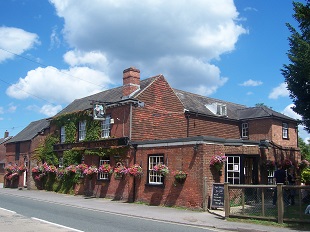
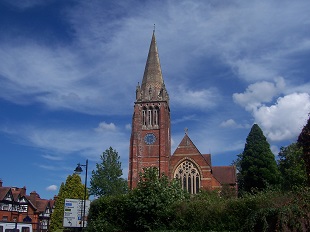 The Snake Catcher pub is situated close to the level crossing in the village of Brockenhurst. It takes its name from Harry "Brusher" Mills, who got his nickname from brushing the local cricket pitch. He gained legendary status from many years of successfully catching snakes and developing an anti-snakebite serum that was used by London Zoo. There was a good choice of meals on offer from sandwiches up to their signature "Snake" dishes.
Lyndhurst Noted as Linhest in 1086, the capital of the New Forest derives its name from the Old English for a wooded hill made up of lime trees. The ancient laws of the Forest are still administered by the verderers from a courthouse here. The parish church stands on high ground at the very heart of Lyndhurst and is a somewhat divergent Victorian brick structure dating to 1860. The Alice Memorial here refers to Alice Hargreaves, who as Alice Liddell had been the inspiration for Lewis Carroll's Alice stories. Lyndhurst enjoys a multiplicity of tea-rooms, restaurants and emporiums, with the New Forest Visitor Centre also being based here. The bells are a satisfying eight that trip round nicely.
The Snake Catcher pub is situated close to the level crossing in the village of Brockenhurst. It takes its name from Harry "Brusher" Mills, who got his nickname from brushing the local cricket pitch. He gained legendary status from many years of successfully catching snakes and developing an anti-snakebite serum that was used by London Zoo. There was a good choice of meals on offer from sandwiches up to their signature "Snake" dishes.
Lyndhurst Noted as Linhest in 1086, the capital of the New Forest derives its name from the Old English for a wooded hill made up of lime trees. The ancient laws of the Forest are still administered by the verderers from a courthouse here. The parish church stands on high ground at the very heart of Lyndhurst and is a somewhat divergent Victorian brick structure dating to 1860. The Alice Memorial here refers to Alice Hargreaves, who as Alice Liddell had been the inspiration for Lewis Carroll's Alice stories. Lyndhurst enjoys a multiplicity of tea-rooms, restaurants and emporiums, with the New Forest Visitor Centre also being based here. The bells are a satisfying eight that trip round nicely.
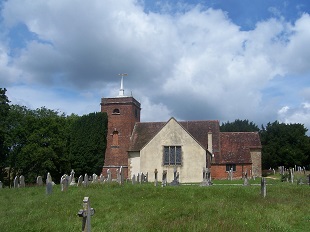
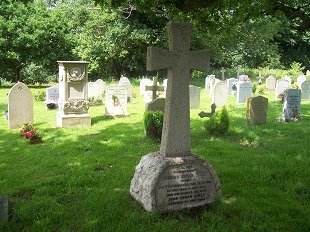 Minstead village nestles in the northern heartland of the Forest and possesses an historic pub, The Trusty Servant, as well as a parish church with a rich heritage that stretches back to Norman times. The C17th three-decker pulpit is made of local oak and one of the Georgian box-pews even has its own fireplace. The ringing room contains two large headstones denoting Sir Arthur Conan Doyle. Given his spiritual beliefs, they were not thought suitable to be displayed atop his grave in the shade of an oak tree in the churchyard. Conan Doyle actually died in Sussex where he was buried. He was later reburied here, close to his former home Bignall House. These five bells are extremely mellifluent and are well worth the visit.
Minstead village nestles in the northern heartland of the Forest and possesses an historic pub, The Trusty Servant, as well as a parish church with a rich heritage that stretches back to Norman times. The C17th three-decker pulpit is made of local oak and one of the Georgian box-pews even has its own fireplace. The ringing room contains two large headstones denoting Sir Arthur Conan Doyle. Given his spiritual beliefs, they were not thought suitable to be displayed atop his grave in the shade of an oak tree in the churchyard. Conan Doyle actually died in Sussex where he was buried. He was later reburied here, close to his former home Bignall House. These five bells are extremely mellifluent and are well worth the visit.

Hinton Admiral · St Michael

Brockenhurst · St Nicholas

The Snake Catcher

Lyndhurst · St Michael

Minstead · All Saints

Conan Doyle lies here
Oxfordshire
Saturday 30th June 2007
10.00am Souldern
Assumption BVM (6) 7cwt
11.30am Fritwell
St Olave (4) 7½ cwt
Hugh Deam, Anthony Hughes, Roy Jones, Judy Kirby, Maarit Kivilo and June Steele.
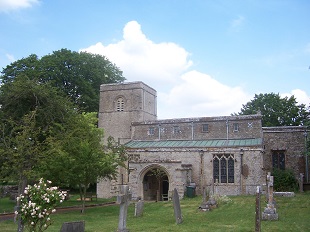
Souldern · Assumption BVM
Souldern The village is quite remotely situated on the far north-eastern edge of the county. A consequence of this is that it possesses the demeanour of both an Oxfordshire and a Northamptonshire village in almost equal parts. The settlement here around 1160 was documented as Sulethorne (a thorn-tree in or near a gully). Souldern Mill, which stands on Ockley Brook, is recorded as being here as far back as 1279. Before enclosure, much of the parish was arable land, but afterwards farmers converted the land to pasture and meadow so as to minimise the amount of tithes they had to pay. The central junction in the village is enhanced by a well-maintained pond which acts as an ideal marker post for directing yourself to the pub (The Fox Inn) or the church. The oldest parts of the parish church are 12th century, with various enlargements and alterations between 1200 and 1500. The mediaeval chancel was rebuilt late in the `19th century and the tower in 1906. The original rectory, built in 1638, had fishponds stocked with carp allied to it by the following century. William Wordsworth stayed at the rectory in 1820 and was inspired to write his sonnet: A Parsonage in Oxfordshire. The present rectory is a replacement from the late 19th century by Gothic Revival architect E.G. Bruton. The church is situated towards the end of a narrow lane leading off from the central point of the village, almost mirroring the positioning of the church at nearby Lower Heyford. The tower contains six bells which are amongst the easiest to ring fluently that you will find. The three oldest bells are by Henry I Bagley of Chacombe, fifth and tenor from 1631, and third from 1635. The front two bells (1907) and the recast fourth bell (1910) are by Mears & Stainbank, Whitechapel.
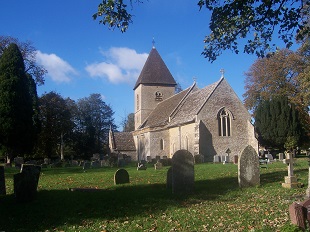 Fritwell The name of the village derives from the Anglo Saxon description for a spring used for divination. The parish church and manor house are situated close together on the western fringe of the village. Although there is no definitive date as to the construction of the house, but it is known to be from the latter half of the 16th century. A grand staircase and sizeable west wing were added during the following century. A later owner, Thomas Garner, restored the building himself in 1893. St. Olave’s church is approached via a short lane arched by mature trees, and bordered by fields populated with sheep. The north and south doorways survive from the original Norman church, with the majority of the building dating to late in the 13th century. The rebuilding of the west tower and the chancel was overseen by G.E. Street in 1865. The dedication of the church evidences the Old Scandinavian (Viking) influence on the area. The original three bells in the tower were augmented to a four in 1949 and have the ideal tone for bringing out the best from minimus methods. The two oldest bells are the second (1612) and the fourth (1618), cast by Robert Atton of Buckingham. The third (1865) and treble (1949) are both from the foundry in Whitechapel.
Fritwell The name of the village derives from the Anglo Saxon description for a spring used for divination. The parish church and manor house are situated close together on the western fringe of the village. Although there is no definitive date as to the construction of the house, but it is known to be from the latter half of the 16th century. A grand staircase and sizeable west wing were added during the following century. A later owner, Thomas Garner, restored the building himself in 1893. St. Olave’s church is approached via a short lane arched by mature trees, and bordered by fields populated with sheep. The north and south doorways survive from the original Norman church, with the majority of the building dating to late in the 13th century. The rebuilding of the west tower and the chancel was overseen by G.E. Street in 1865. The dedication of the church evidences the Old Scandinavian (Viking) influence on the area. The original three bells in the tower were augmented to a four in 1949 and have the ideal tone for bringing out the best from minimus methods. The two oldest bells are the second (1612) and the fourth (1618), cast by Robert Atton of Buckingham. The third (1865) and treble (1949) are both from the foundry in Whitechapel.

Fritwell · St Olave
Northamptonshire
Saturday 5th May 2007
10.00am Blakesley
St Mary (5) 12cwt
11.30am Bradden
St Michael (5) 8cwt
02.30pm Syresham
St James (5) 9cwt
Alan Coates, Hugh Deam, Simon Edwards, Roy Jones and Maarit Kivilo.
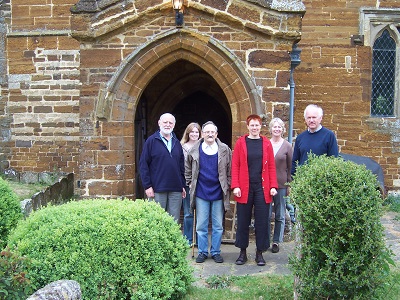
Blakesley
Blakesley The village was noted in the Domesday Book (1086) as Blaculveslei (a woodland clearing in the possession of Blaecwulf). For many centuries, the village had one of the most historic manor houses of the county – Blakesley Hall – but sadly this 13th century mansion was demolished in 1957/58. The deep brown ironstone parish church has a west tower that is made up of rough grey blocks, with a decidedly interesting clock that is easy to date as the quarter hours are bordered by the numbers, 1, 8, 9 and 7. The chancel was rebuilt by Edmund Law at this time, with the south chapel added as a direct result of monies left to the church by a parishioner. The bells are a testing, but ultimately rewarding, set of five, rung from the ground floor. The two oldest bells are the second and fifth (1673), cast by Henry I Bagley of Chacombe. The treble is from 1832 by John Taylor and the third and fourth (1854) are from Whitechapel. As an added bonus the local ringers were exceptionally hospitable, a generation having passed without any ringing here until a new team was formed with the express aim of ringing to mark the 200th anniversary of the Battle of Trafalgar in 2005.
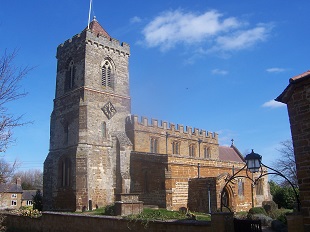
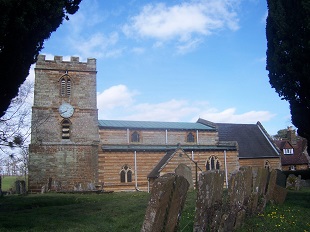 Bradden The name of the village derives from the Anglo-Saxon for a broad valley, with documentation as Bradene in 1086. The manor house has a typical Georgian-style frontage, dating to 1819, having been built as a replacement for the pre-Reformation mansion that stood on the same site. Some of the internal walls are thought to have previously been external walls of the original building. The archetypal Northamptonshire parish church is located on the northern fringe of the village, with the oldest part being the broad and unbuttressed west tower which dates to the 13th century, with the chancel also of that general period. The west bay and south arcade were added slightly later. A major restoration in 1858 was overseen by William White. The bells are rung from the ground floor, but are much less taxing on bell-handling than many of the neighbouring towers. All five bells were cast in 1929 by Taylors of Loughborough.
Bradden The name of the village derives from the Anglo-Saxon for a broad valley, with documentation as Bradene in 1086. The manor house has a typical Georgian-style frontage, dating to 1819, having been built as a replacement for the pre-Reformation mansion that stood on the same site. Some of the internal walls are thought to have previously been external walls of the original building. The archetypal Northamptonshire parish church is located on the northern fringe of the village, with the oldest part being the broad and unbuttressed west tower which dates to the 13th century, with the chancel also of that general period. The west bay and south arcade were added slightly later. A major restoration in 1858 was overseen by William White. The bells are rung from the ground floor, but are much less taxing on bell-handling than many of the neighbouring towers. All five bells were cast in 1929 by Taylors of Loughborough.
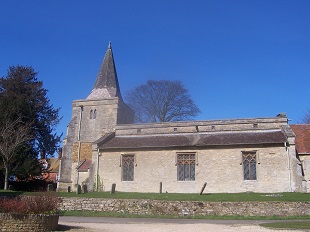 Syresham Referencing Sigehere’s estate, the settlement here at the time of the Domesday Book was known as Sigresham. The village is surrounded by the remnants of ancient woodland and royal hunting grounds, and includes the hamlets of Crowfield and Pimlico. Syresham has a number of particularly fine Georgian buildings, including the rectory and gatehouse, the latter of which is an unusual composite construction of timber from old dismantled barns in the area, with subsequent brick infilling from around 1930 by Biddulph-Pinchard. The chancel arch of the elegant parish church dates to around 1200 and is considered to be a prime example of late Norman work. The circular Norman font has rope-moulding at the top. The grey-stone west tower with a band of ironstone is of the latter part of the 13th century, being capped by a short recessed shingled spire. The bells are set in a counter-clockwise configuration, the three oldest (treble, second, fourth) dating to 1624, cast by Robert Atton of Buckingham. The third is from later in that century, cast by the Bagley family in Chacombe, 1687. The fifth is from 1867 by John Warner & Sons, London.
Syresham Referencing Sigehere’s estate, the settlement here at the time of the Domesday Book was known as Sigresham. The village is surrounded by the remnants of ancient woodland and royal hunting grounds, and includes the hamlets of Crowfield and Pimlico. Syresham has a number of particularly fine Georgian buildings, including the rectory and gatehouse, the latter of which is an unusual composite construction of timber from old dismantled barns in the area, with subsequent brick infilling from around 1930 by Biddulph-Pinchard. The chancel arch of the elegant parish church dates to around 1200 and is considered to be a prime example of late Norman work. The circular Norman font has rope-moulding at the top. The grey-stone west tower with a band of ironstone is of the latter part of the 13th century, being capped by a short recessed shingled spire. The bells are set in a counter-clockwise configuration, the three oldest (treble, second, fourth) dating to 1624, cast by Robert Atton of Buckingham. The third is from later in that century, cast by the Bagley family in Chacombe, 1687. The fifth is from 1867 by John Warner & Sons, London.

Blakesley · St Mary

Bradden · St Michael

Syresham · St James
Training Morning
Saturday 21st April 2007
09.30am Thame
SMV (8) 11cwt
11.30am Chinnor
St Andrew (6) 10cwt
01.00pm The Village Centre
Chinnor
Andy Bryant, Jane Burgess, Ron Burgess, Hugh Deam, Clare Fairburn, Malcolm Fairburn, Marion Hollick, Anthony Hughes, Roy Jones, Susan King, Judy Kirby, Katie Lane, Peter Lloyd, Donna Murphy and Gordon Smith.
Grandsire Triples, Cambridge, St Clements, Stedman & St Simon's.
Thame The 13th century cruciform church was built under the orders of Bishop Grosseteste and the 15th century tower was heightened during the course of late 19th century restoration work. There are many significant monuments within the church as the carvings are the work of craftsmen belonging to the elite Southward School of Sculptors. The capacious ringing chamber gives evidence to the heightening work.
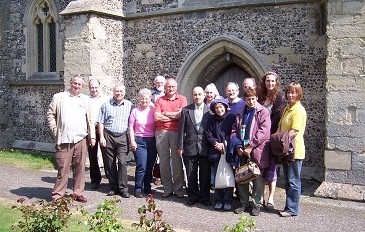
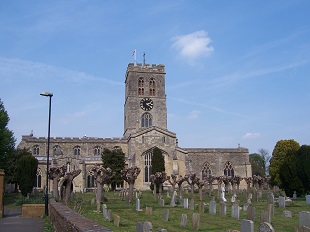 The bells are a little tricky for handling around the front end, but the back bells are ideal for pulling in. See Saturday 28th April 2001 for details of the town.
Chinnor This seemingly sprawling village was actually conceived as a quadrangle layout at a crossing of route-ways on the Chiltern escarpment, the original settlement being known as Chenmore (Ceonna's slope). During the English Civil War many houses were damaged following a dawn raid by Royalist troops who had resorted to guerrilla tactics, having used the nearby woods as a hideout. This damage was as nought by comparison with the devastation wrought by two huge fires that swept through the village, sparing little, not even the church. The reconstructed parish church stands on the site of the Norman predecessor. The superb wall paintings that adorn the interior are the work of Sir James Thornbill, who most notably painted the inside of the great dome of St Paul's Cathedral. The bells are a reassuring ring of six, although it should be taken into consideration that the fourth is deep set. The back four bells were cast by the Knight family at their foundry in Reading between 1586 (tenor) and 1663 (fourth). The front two bells were added in 1969 by Taylors of Loughborough.
The bells are a little tricky for handling around the front end, but the back bells are ideal for pulling in. See Saturday 28th April 2001 for details of the town.
Chinnor This seemingly sprawling village was actually conceived as a quadrangle layout at a crossing of route-ways on the Chiltern escarpment, the original settlement being known as Chenmore (Ceonna's slope). During the English Civil War many houses were damaged following a dawn raid by Royalist troops who had resorted to guerrilla tactics, having used the nearby woods as a hideout. This damage was as nought by comparison with the devastation wrought by two huge fires that swept through the village, sparing little, not even the church. The reconstructed parish church stands on the site of the Norman predecessor. The superb wall paintings that adorn the interior are the work of Sir James Thornbill, who most notably painted the inside of the great dome of St Paul's Cathedral. The bells are a reassuring ring of six, although it should be taken into consideration that the fourth is deep set. The back four bells were cast by the Knight family at their foundry in Reading between 1586 (tenor) and 1663 (fourth). The front two bells were added in 1969 by Taylors of Loughborough.
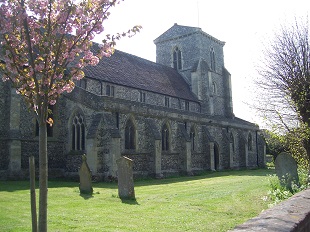
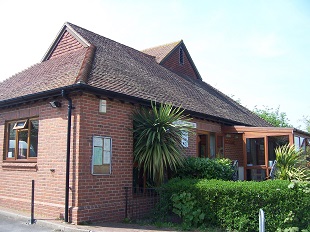 Not only is Chinnor vibrant enough to retain once integral shops such as a butcher, post office and ironmongers, it is also fortunate enough to have a Village Centre that is operated by volunteers with a café in operation seven days a week, serving great value meals. This superb facility has been featured on television several times as it was one of the very first community-led all-purpose hubs.
Not only is Chinnor vibrant enough to retain once integral shops such as a butcher, post office and ironmongers, it is also fortunate enough to have a Village Centre that is operated by volunteers with a café in operation seven days a week, serving great value meals. This superb facility has been featured on television several times as it was one of the very first community-led all-purpose hubs.

Thame

Thame · SMV

Chinnor · St Andrew

The Village Centre · Chinnor
North Downs, Surrey
Saturday 24th March 2007
10.45am Shere
St James (8) 15cwt
11.55am Albury
St Peter & St Paul (6) 16cwt
01.30pm The Sun Inn
Dunsfold
02.45pm Dunsfold
St Mary & All Saints (6) 10cwt
03.45pm Alfold
St Nicholas (6) 6cwt
John Beale, Jonathan Beale, Jane Burgess, Ron Burgess, Victor Coles, Hugh Deam, Adrian Gray, Roy Jones, Susan King, Judy Kirby, Janice Knowles, Peter Lloyd, Paul Lucas, Donna Murphy, Ailsa Reid, June Steele and William Stungo.
Grandsire Triples, St Clements, Little Bob, Plain Bob Minor & Stedman.
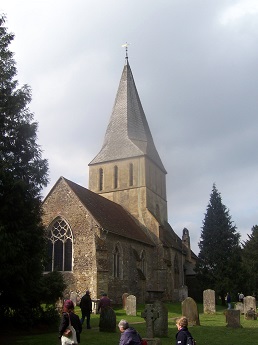
Shere · St James
Shere Having rung at the "Alpine Village" of Chalford in Gloucestershire the previous autumn, it was fascinating to visit Surrey's own equivalent so soon after. The village takes its name from the Anglo Saxon for a place at a clear stream. The decided similarity to high rural areas of Germany is easy to spot. Within the village centre conservation area are 34 listed buildings that pre-date 1830, with a blacksmith, trekking centre, tea house, art gallery and two pubs all adding to the Ruritanian feel. The Early English parish church of 1190 is reached on foot via a bridge that crosses the Tillingbourne stream, with the churchyard entered through a fine lych-gate of 1902, which was designed by Sir Edwin Lutyens. The church is constructed of ironstone rubble, with sandstone buttresses, having been restored in 1895 by S. Weatherley. Inside the church is an oak crusader chest dating to 1200 which was ordered by Pope Innocent III. The Bray Chapel is named after the Lords of the Manor in Shere. The broad tower contains eight bells, the third, fourth and fifth bells being survivors of six bells recast in 1712 by Richard Phelps from the metal of the original five bells of the 16th century. With the exception of the sixth (Gillett & Johnston, 1886), all the other bells were also cast at Whitechapel (1895 & 1976). An unusual feature of the ringing chamber is the clock which counts backwards.
Albury This now extensive village takes its name from the Anglo-Saxon description for an old stronghold, being documented as Ealdeburi in 1062. The original part Saxon and part Norman parish church, of the same dedication, is situated within Albury Park, on the eastern side of the village, and is now under the care of the Churches Conservation Trust. During the 19th century there was a major schism within the church locally, and the owners of the estate ordered an Anglo-Catholic church built adjacent to the manor house and the installation of a rector of their choice. However, the rector later converted back to a less High-Church outlook and subsequently fell out with the owners, and as a result a third church had to be built as the new housing the village was re-sited halfway up St Martha's Hill.
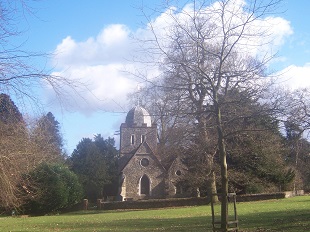
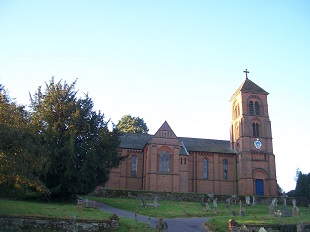 The Duke and Duchess of Northumberland provided the necessary funds for the construction of the new church, and the leading figure in church design at that time Arthur Blomfield was commissioned to oversee the work here at the same time as he was working on St Barnabas in Oxford. The north chapel was later added to the designs of Sir Edward Maufe, who most notably designed Guildford Cathedral and the Oxford Playhouse theatre. All of the bells were cast in 1935 by Taylors of Loughborough, and are arguably the best sounding six in the county.
Dunsfold A settlement here was first noted as Duntesfaunde (Dunt's fold or enclosure) in 1259. Dunsfold Airfield was used by two separate Free Dutch Air Force groups during the Second World War, with B25 Bombers flown from here.
The Duke and Duchess of Northumberland provided the necessary funds for the construction of the new church, and the leading figure in church design at that time Arthur Blomfield was commissioned to oversee the work here at the same time as he was working on St Barnabas in Oxford. The north chapel was later added to the designs of Sir Edward Maufe, who most notably designed Guildford Cathedral and the Oxford Playhouse theatre. All of the bells were cast in 1935 by Taylors of Loughborough, and are arguably the best sounding six in the county.
Dunsfold A settlement here was first noted as Duntesfaunde (Dunt's fold or enclosure) in 1259. Dunsfold Airfield was used by two separate Free Dutch Air Force groups during the Second World War, with B25 Bombers flown from here.
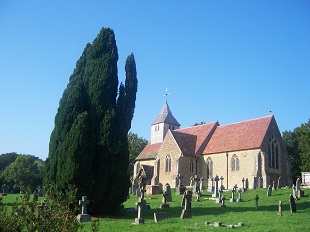
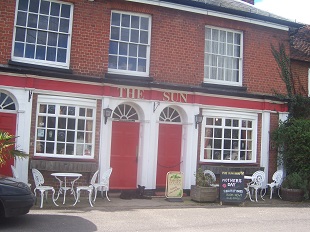 The Sun Inn looks out on to the village common and cricket pitch, with parts of the building being over 500 years old. All who had lunch here were more than satisfied, with the desserts equally sublime as the main courses. The pub is Grade II Listed and boasts intriguing décor and fittings, plus a roaring log fire burnishing the cold days. The parish church is one of the most beautifully appointed in the country, being approached via a long avenue of ancient yew trees, surrounded by a huge churchyard, a smattering of cottages and overlooked by high woodland. The yew tree adjacent to the church is older than the building itself, which dates to 1270 and is the work of royal masons which accounts for the exceptionally high quality of craftsmanship that is to be found throughout. Leading figures in appraising church buildings down the years have been in concurrence as to the veritably high standing to which this church should be held. The bell turret dates from the 15th century, with the bells rung from the ground floor. All six bells were cast in 1946 by Gillett & Johnston.
The Sun Inn looks out on to the village common and cricket pitch, with parts of the building being over 500 years old. All who had lunch here were more than satisfied, with the desserts equally sublime as the main courses. The pub is Grade II Listed and boasts intriguing décor and fittings, plus a roaring log fire burnishing the cold days. The parish church is one of the most beautifully appointed in the country, being approached via a long avenue of ancient yew trees, surrounded by a huge churchyard, a smattering of cottages and overlooked by high woodland. The yew tree adjacent to the church is older than the building itself, which dates to 1270 and is the work of royal masons which accounts for the exceptionally high quality of craftsmanship that is to be found throughout. Leading figures in appraising church buildings down the years have been in concurrence as to the veritably high standing to which this church should be held. The bell turret dates from the 15th century, with the bells rung from the ground floor. All six bells were cast in 1946 by Gillett & Johnston.
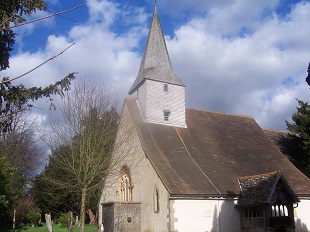
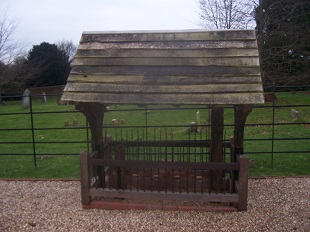 Alfold The village takes its name from the Saxon words to describe an enclosure for animals, the settlement having been built amidst Wealdon Forest. During the 18th and 19th centuries many local houses were used as hiding places for kegs of brandy, and other contraband from France, by smugglers with a fearsome reputation. Perhaps this goes some way to explain the fine set of stocks, with room for two people, just outside the churchyard, these being one of the very few remaining complete sets in the county. In the churchyard is the grave of Jean Carre who introduced Lorraine Glass to England in 1567, this glass being ideal for glazing. The parish church here was first documented during the reign of Henry III. In 1842 the then rector, John Sparkes recovered several earlier or original furnishings, including the magnificent communion table-top made of Sussex marble. The original three bells (1625 & 1631), now the back three, were cast at the Chertsey foundry of the Eldridge family. For some ninety years the bells were only chimed, this being until the culmination of several years of fund-raising resulted in them being augmented to a superb ring of six in 2003, the present front three cast by Taylors of Loughborough.
Alfold The village takes its name from the Saxon words to describe an enclosure for animals, the settlement having been built amidst Wealdon Forest. During the 18th and 19th centuries many local houses were used as hiding places for kegs of brandy, and other contraband from France, by smugglers with a fearsome reputation. Perhaps this goes some way to explain the fine set of stocks, with room for two people, just outside the churchyard, these being one of the very few remaining complete sets in the county. In the churchyard is the grave of Jean Carre who introduced Lorraine Glass to England in 1567, this glass being ideal for glazing. The parish church here was first documented during the reign of Henry III. In 1842 the then rector, John Sparkes recovered several earlier or original furnishings, including the magnificent communion table-top made of Sussex marble. The original three bells (1625 & 1631), now the back three, were cast at the Chertsey foundry of the Eldridge family. For some ninety years the bells were only chimed, this being until the culmination of several years of fund-raising resulted in them being augmented to a superb ring of six in 2003, the present front three cast by Taylors of Loughborough.

Albury · The original church

Albury · St Peter & St Paul

Dunsfold · St Mary

The Sun Inn · Dunsfold

Alfold · St Nicholas

The Alfold stocks
Northamptonshire
Saturday 27th January 2007
10.00am Croughton
All Saints (5) 9cwt
11.00am Shalstone
St Edward the Confessor & King (5) 7cwt
Hugh Deam, Simon Edwards, Roy Jones, Maarit Kivilo and David Moore.
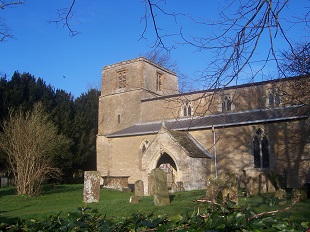
Croughton · All Saints
Croughton Taking its name from a farmstead on a fork of land, the village now stretches to some considerable length, with new housing springing up at a steady rate. The settlement grew up around the Ockley Brook, a tributary of the River Cherwell. Croughton is probably best known to motorists for the telecommunication masts that are part of the USAF 422nd Air Base Group communications station, which in reality is also a monitoring and listening station, and thought to have been the section responsible for the hacking of Chancellor Angela Merkel’s mobile phone in 2012. RAF Croughton was established in 1938 and renamed RAF Brackley during the Second World War and reverting back to its original name after the war. The parish church is situated near the end of a narrow lane that is bordered for most of its length by handsome timber-framed cottages. The primarily 12th to 14th century church is constructed of coursed limestone rubble, lead and slate-roofed.
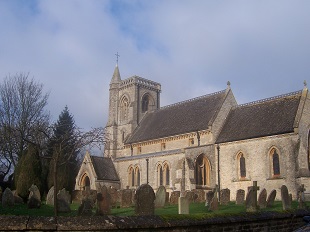 There are some two dozen interpretations of biblical scenes amongst the 14th century wall-paintings, depicting as they do the Passion Cycle. The relatively low west tower houses five bells which are rung from the ground floor. All five bells were cast in 1923 by Taylors of Loughborough.
Shalstone The village derives its name from the early settlement known as Celdestone (a farmstead by a stream). Shalstone was long an estate-village, with the FitzGerald family having ownership of Shalstone House. This primarily Georgian building was extensively renovated and embellished by Sir George Gilbert Scott in 1861/62. Of the 13th century chapel that stood here, only the north aisle remains intact after the comprehensive rebuilding of the church in the late 19th century, also conducted by Scott. The west tower had its stair-turret heightened and was crowned by a spirelet during this period of work. The numerous 19th century monuments inside the church are by Sir Robert Westmacott, who is chiefly remembered for his work on the Houses of Parliament. Before the reconstruction work there were even more memorial tablets than there are now, with most of those which survive being dedicated to various members of the Purefoy family and the Jervoise family. The bells are rung from the ground floor and are extremely fluent, all five of them having been cast by George Mears at Whitechapel in 1862.
There are some two dozen interpretations of biblical scenes amongst the 14th century wall-paintings, depicting as they do the Passion Cycle. The relatively low west tower houses five bells which are rung from the ground floor. All five bells were cast in 1923 by Taylors of Loughborough.
Shalstone The village derives its name from the early settlement known as Celdestone (a farmstead by a stream). Shalstone was long an estate-village, with the FitzGerald family having ownership of Shalstone House. This primarily Georgian building was extensively renovated and embellished by Sir George Gilbert Scott in 1861/62. Of the 13th century chapel that stood here, only the north aisle remains intact after the comprehensive rebuilding of the church in the late 19th century, also conducted by Scott. The west tower had its stair-turret heightened and was crowned by a spirelet during this period of work. The numerous 19th century monuments inside the church are by Sir Robert Westmacott, who is chiefly remembered for his work on the Houses of Parliament. Before the reconstruction work there were even more memorial tablets than there are now, with most of those which survive being dedicated to various members of the Purefoy family and the Jervoise family. The bells are rung from the ground floor and are extremely fluent, all five of them having been cast by George Mears at Whitechapel in 1862.

Shalstone · St Edward
